医学英语临床诊断学
- 格式:doc
- 大小:95.00 KB
- 文档页数:11
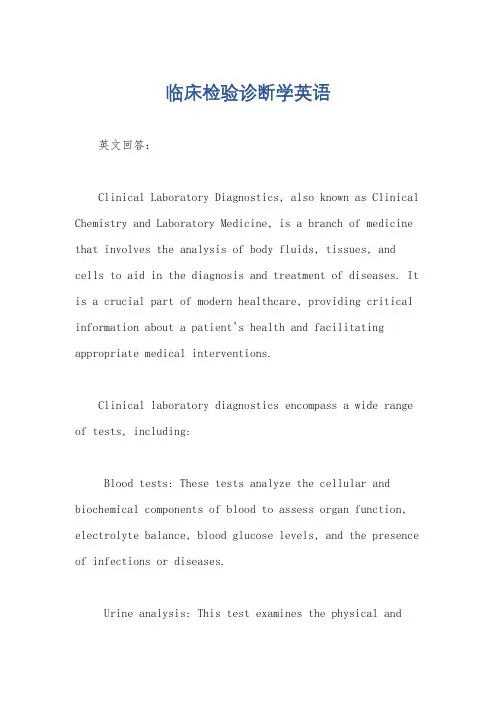
临床检验诊断学英语英文回答:Clinical Laboratory Diagnostics, also known as Clinical Chemistry and Laboratory Medicine, is a branch of medicine that involves the analysis of body fluids, tissues, and cells to aid in the diagnosis and treatment of diseases. It is a crucial part of modern healthcare, providing critical information about a patient's health and facilitating appropriate medical interventions.Clinical laboratory diagnostics encompass a wide range of tests, including:Blood tests: These tests analyze the cellular and biochemical components of blood to assess organ function, electrolyte balance, blood glucose levels, and the presence of infections or diseases.Urine analysis: This test examines the physical andchemical properties of urine to evaluate kidney function and detect abnormalities that may indicate underlying health conditions.Tissue biopsy: A biopsy involves the removal of a small piece of tissue for microscopic examination. This procedure can help diagnose cancer, infections, and other diseases.Microbiology: This discipline focuses on the identification and characterization of microorganisms, such as bacteria and viruses, to diagnose and treat infectious diseases.Immunology: Immunology tests measure the body's immune response to antigens, aiding in the diagnosis and monitoring of autoimmune diseases, allergies, and immunodeficiencies.Clinical laboratory diagnostics play a pivotal role in modern healthcare by:Confirming or excluding diagnoses: Laboratory testscan provide definitive evidence of a disease or rule out potential diagnoses.Monitoring disease progression and treatment: Serial laboratory tests can track the effectiveness of treatment and monitor the progression of diseases over time.Assessing risk factors and predicting disease outcomes: Laboratory tests can identify individuals at risk forcertain diseases and predict the likelihood of disease progression or recurrence.Guiding treatment decisions: Laboratory results can guide healthcare professionals in selecting appropriate treatments and therapies based on the patient's specific needs.To ensure accuracy and reliability, clinicallaboratories follow strict protocols and adhere to quality control measures. The field of clinical laboratory diagnostics is continuously evolving, with new technologiesand advancements emerging to enhance diagnosticcapabilities and improve patient care.中文回答:临床检验诊断学,又称临床化学和检验医学,是医学的一个分支,涉及分析体液、组织和细胞,以辅助疾病的诊断和治疗。
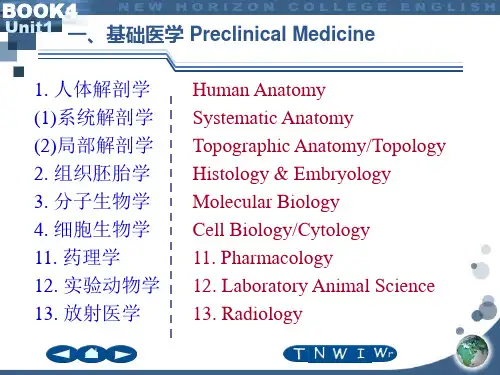

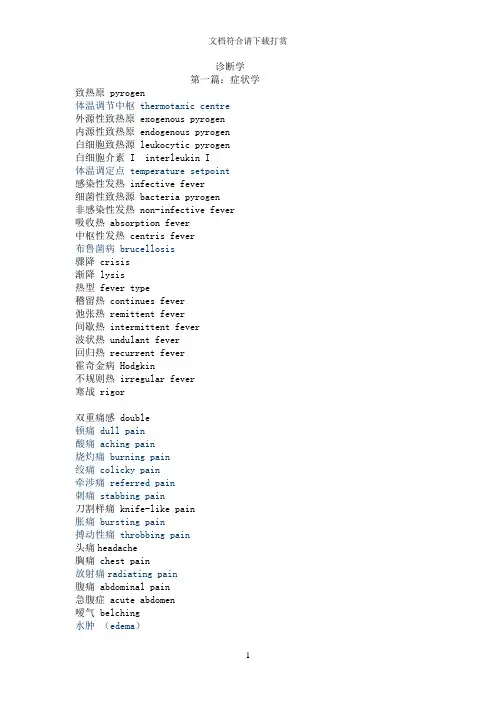
诊断学第一篇:症状学致热原 pyrogen体温调节中枢 thermotaxic centre外源性致热原 exogenous pyrogen内源性致热原 endogenous pyrogen白细胞致热源 leukocytic pyrogen白细胞介素 I interleukin I体温调定点 temperature setpoint感染性发热 infective fever细菌性致热源 bacteria pyrogen非感染性发热 non-infective fever吸收热 absorption fever中枢性发热 centris fever布鲁菌病 brucellosis骤降 crisis渐降 lysis热型 fever type稽留热 continues fever弛张热 remittent fever间歇热 intermittent fever波状热 undulant fever回归热 recurrent fever霍奇金病 Hodgkin不规则热 irregular fever寒战 rigor双重痛感 double顿痛 dull pain酸痛 aching pain烧灼痛 burning pain绞痛 colicky pain牵涉痛 referred pain刺痛 stabbing pain刀割样痛 knife-like pain胀痛 bursting pain搏动性痛 throbbing pain头痛headache胸痛 chest pain放射痛radiating pain腹痛 abdominal pain急腹症 acute abdomen嗳气 belching水肿(edema)积水 dropsy象皮腿 elephantiasic crus皮肤黏膜出血 mucocutaneous hemorrhage 血小板无力症 thrombasthenia呼吸困难 dyspnea心原性哮喘 cardiac asthma咳嗽 cough咳痰 expectoration咳血 hemoptysis紫绀(cyanosis)心悸(palpitation)恶心 nausea呕吐 vomiting干呕 vomiturition呕吐中枢 vomiting center呕血 hematemesis正铁血红蛋白 hematin黑便 melena便血 hematochezia隐血便 stool with occult blood柏油便 tarry stool里急后重 tenesmus腹泻diarrhea便秘(constipation)黄疸(jaundice)隐性黄疸 latent jaundice旁路胆红素 bypass bilirubin非结合胆红素 unconjugated bilirubin 结合胆红素 conjugated bilirubin核黄疸 nuclear icterus眩晕vertigo惊厥convulsion意识障碍disturbance of consciousness 嗜睡 somnolence意识模糊 confusion昏睡 stupor昏迷 coma谵妄delirium血尿 hematuria尿频 frequent micturition 尿急 urgent micturition 尿痛odynuria 神经原性膀胱 neurogenic bladder 排尿困难dysuria尿失禁urinary incontinence尿潴留retention of urine第二篇问诊(inquiry)一般项目general data主诉 chief complaints现病史 history of present illness既往史 past history系统回顾systems review个人史 personal history婚姻史 marrital history月经史 menstrual history生育史 childbearing history家族史 family history第三篇检体诊断(physical diagnosis)第1章体格检查 physical examination 视诊 inspection触诊 palpation浅部触诊法 light palpation深部触诊法 deep palpation双手触诊法 bimanual palpation 深压触诊法 deep press palpation 冲击触诊法 ballottement叩诊 percussion间接叩诊法 indirect percussion 直接叩诊法 direct percussion 清音 resonance浊音 dullness鼓音 tympany实音 flatness过清音 hyperresonance听诊 auscultation听诊器 stethoscope嗅诊 olfactory examination 深部滑行触诊法deep slipping palpation腋臭 bromidrosis第2章性别 sex萎黄病 chlorosis年龄 age生命征 vital sign体温 temperature发育 development青春期急激成长 adolescent spurt 体型 habitus无力型(瘦长型) asthenic type超力型(矮胖型) sthenic type正力型(均称型) ortho-sthenic type 巨人症 gigantism垂体性侏儒症pituitary dwarfism 良好 well不良 poorly中等 fairly消瘦 emaciation恶病质 cachexia肥胖 obesity水牛背 buffalo hump意识状态 consciousness语调 tone语态 voice面容 facial features表情 expression肝病面容 hepatic facies肾病面容 nephritic facies二尖瓣面容 mitral facies肢端肥大症面容 acromegaly facies 伤寒面容 typhoid facies苦笑面容 sardonic feature满月面容 moon facies面具面容 masked facies病危面容critical facies/Hippocrates体位 position自主体位 active position被动体位 positive position强迫体位 compulsive position端坐呼吸 orthopnea强迫蹲位 compulsive squatting强迫停立位forced standing position辗转体位 alternative position角弓反张位 opisthotonos position 姿势 posture步态 gait蹒跚步态wadding gait醉酒步态 drinken man gait共济失调步态 ataxic gait慌张步态 festinating gait跨阈步态 steppage gait剪刀式步态 scissors gait 间歇性跛行intermittent claudication皮肤黏膜苍白 pallor皮肤发红 redness发绀 cyanosis黄染 stained yellow胡萝卜素 carotene黑色素 melanin色素沉着 pigmentation老年斑 senile plaque白癜 vitiligo白斑 leukoplakia白化症 albinismus湿度 moisture皮肤弹性 elasticity皮疹 skin eruption斑疹 maculae玫瑰疹 roseola丘疹 papules斑丘疹 maculopapulae寻麻疹 urticaria皮肤脱屑 desquamation瘀点 petechia紫癜 purpura瘀班 ecchymosis血肿 hematoma蜘蛛痣 spider angioma水肿 edema压陷性水肿pitting edema皮下结节 subcutaneous nodule 斑痕 scar毛发 hair第3章头部头发 hair头皮 scalp头颅 skull小颅 micro cephalia 尖颅 oxycephaly塔颅 tower skull 方颅 squared skull 巨颅 large skull长颅 delichocephalia 变形颅 deforming skull 震颤麻痹Parkinson颜面 face眼眉 eyebrow眼睑 eyelids睑内翻 entropion上睑下垂 ptosis结膜 conjunctiva眼球 eyeball眼球突出 exophthalmos复视 diplopia斜视 paralytic squint眼球震颤 nystagmus巩膜 sclera角膜 cornea老年环 arcus senilis肝豆状核变性 Wilson病虹膜 iris瞳孔 pupil调节反射 accommodation reflex 辐辏反射 convergence reflex视力 vision色觉 color sensation耳廓 auricle外耳道 external auditory canal 鼓膜 ear drum乳突 mastoid听力 auditus酒渣鼻 rosacea鞍鼻 saddle nose鼻翼扇动 nasal ala flap 鼻衄 epistaxis鼻窦 nasal sanus口 mouth克汀病 cretinism黏液性水肿 myxedema肢端肥大症 acromegaly麻疹黏膜斑measles mucous patch牙齿 teeth牙龈 gums舌 tongue渴感 thirst舌痛 Sore tongue地图舌 geographic tongue移行性舌炎 migratory glossitis 裂纹舌 wrinkled tongue草莓舌 strawberry tongue牛肉舌 beefy tongue镜面舌(光滑舌)smooth tongue毛舌 hairy tongue鼻咽 nasopharynx口咽 oral pharynx咽喉 laryngeal pharynx喉 larynx腮腺 parotid gland第4章颈部斜颈 torticollis静脉“翁鸣” venous hum甲状腺 thyroid 第5章胸部胸骨上切迹suprasternal notch胸骨柄 manubrium sterni胸骨角 sternal angle / Louis 胸骨下角 infrasternal angle 剑突 xiphoid process浮肋 free ribs肋间隙 intercostal space肩胛骨 scapula脊柱棘突 spinous process肋脊角 costalspinal angle前正中线 anterior midline 锁骨中线 midclavicular line胸骨线 sternal line胸骨旁线 parasternal line腋前线 anterior axillary line 腋后线 posterior axillary line 腋中线 midaxillary line肩胛线 scapular line后正中线 posterior midline腋窝 axillary fossa胸骨上窝 suprasternal fossa锁骨上窝 supraclavicular fossa 锁骨下窝 infraclavicular fossa对称性 symmetry肩胛上区 suprascapular region 肩胛下区 infrascapular region 肩胛间区 interscapular region 脏层胸膜 visceral pleura壁层胸膜 parietal pleura胸壁 chest wall皮下气肿 subcutaneous emphysema 捻发音 crepitus扁平胸 flat chest桶状胸 barrel chest佝偻病胸 rachitic chest佝偻病串珠 rachitic rosary肋膈沟 Harrison groove漏斗胸 funnel chest鸡胸 pigeon chest乳房 breast乳晕 areola乳头 nipple内翻 inversion皮肤回缩 skin retraction硬度 consistency弹性 elasticity压痛 tenderness包块 masses部位 location大小 size外形 contour活动度 mobility三凹征 three depressions sign 呼吸过速 tachypnea呼吸过缓 bradypnea胸廓扩张度 thoracic expansion 语音振颤 vocal fremitus触觉振颤 tactile fremitus空瓮音 amphorophony胸膜摩擦感pleural friction fremitus肺泡呼吸音 vesicular breath sound支气管呼吸音bronchial breath sound齿轮呼吸音 cogwheel breath sound罗音 rale附加音 adventitious sound湿性罗音 moist rales水泡音 bubble sound爆裂音 crackles干性罗音 rhonchi语音共振 vocal resonance支气管语音 bronchophony胸语音 pectoriloquy羊鸣音 egophony耳语音 whispered胸膜摩擦音 pleural friction rub 硬币扣击征 coin sign大叶性肺炎 lobar pneumonia支气管哮喘 bronchial asthma胸腔积液 pleural effusion气胸 pneumothorax心尖搏动 apical impulse振颤 thrill早搏 premature beat房颤 atrial fibrillation短绌脉 pulse deficit大炮音 cannon sound钟摆律 pendular rhythm胎心律 embryocardia心音分裂 splitting of heart sounds 生理分裂 physiologic splitting固定分裂 fixed splitting 反常分裂 paradoxical splitting 逆分裂 reversed splitting三音律 triple rhythm四音律 quadruple rhythm奔马律 gallop rhythm舒张期奔马律protodiastolic gallop舒张晚期奔马律late diastolic gallop室性奔马律 ventricular gallop收缩期前奔马律 resystolic gallop 房性奔马律 atrial gallop重叠奔马律 summation gallop开瓣音 opening snap心包扣击音 pericardial knock肿瘤扑落音 tumor plop收缩期喷射音systolic ejection sounds咯剌音 click心脏杂音 cardiac murmurs层流 lamina flow湍流 turbulent flow旋涡 vortices收缩期杂音 systolic murmur舒张期杂音 diastolic murmur连续性杂音 continuous murmur 心包摩擦音pericardial friction sound脱落脉 dropped pulse洪脉 pulsus magnus跳脉 bounding pulse细脉 small pulse丝脉 thready pulse水冲脉 water hammer pulse迟脉pulsus tardus重搏脉 dicrotic pulse交替脉 pulsus alternans奇脉 paradoxical pulse无脉病 pulseless血压 blood pressure / BP脉压 pulse pressure颈静脉嗡鸣声 venous hum射枪音 pistol shot毛细血管搏动 capillary pulsation 心包积液 pericardial effusion毛细血管楔嵌压 pulmonary capillary wedge pressure / PCWP 第6章腹部左季肋部 left hypochondrium 左腰部 left lumber region左髂部 left iliac region上腹部 epigastric region脐部 umbilical region下腹部hypogastric region腹部膨隆 abdominal bulge腹水 ascites蛙腹 frog belly尖腹 apical belly气腹 pneumoperitoneum舟状腹 scaphoid abdomen腹部凹陷 abdominal retraction 恶病质 cachexia腹壁静脉曲张abdominal wall varicosis海蛇神头 caput medusae胃肠型gastral or intestinal pattern蠕动波 peristalsis板状腹 board-like rigidity揉面感dough kneading sensation压痛 tenderness反跳痛 rebound tenderness波动感 fluctuation肝震颤 liver thrill液波震颤 fluid thrill振水音 succussion胃泡鼓音区 Traube区移动性浊音 shifting dullness 尺压实验 ruler pressing test 肠鸣音 borborygmus搔弹音 scratch sound急性腹膜炎 acute peritonitis 肝硬化 liver cirrhosis蜘蛛志 spider肝掌 liver palms 蛙腹 frog belly肠梗阻 intestinal obstruction第七章生殖器、肛门、直肠阴茎 penis勃起 erection包皮 prepuce阴囊 scrotum精索 spermatic cord睾丸 testis会阴 perineum隐睾症 cryptorchism附睾 epididymis腹股沟斜疝indirect inguinal hernia前列腺 epididymis精囊 seminal vesicle阴阜 mons veneris大阴唇 labium majus pudendi 小阴唇 labium minus pudendi 阴蒂 clitoris 阴道前庭 vestibulum vaginae 阴道 vagina处女膜 hymen子宫 uterus输卵管 oviduct卵巢 ovary直肠 rectum肛门 anus肛管 anal canal肛门闭锁 proctatresia肛裂 anal fissure痔 hemorrhoid内痔 internal hemorrhoid外痔 external hemorrhoid混合痔 mixed hemorrhoid肛瘘 archosyrinx直肠脱垂 proctoptosis脱肛 hedrocele直肠息肉 proctopolypus第8章脊柱与四肢脊柱 spine驼背 gibbus脊柱前凸 lordosis姿势性侧凸 posture scoliosis 器械性侧凸 organic scoliosis 四肢 four limbs关节 articulus匙状甲 koilonychia杵状指 acropachy 肢端肥大症 acromegaly膝内翻 genua varus膝外翻 genua valgus肌肉萎缩 muscle atrophy淋巴性水肿 lymphedema象皮肿 elephant edema爪行手 claw hand浮髌现象floating patella phenomenon第9章神经系统检查嗅神经 olfactory nerve视神经 optic nerve视力 vission视野 visual feild动眼神经 oculomotor nerve 滑车神经 trochlear nerve 三叉神经 trigeminus展神经 abduct nerve 面神经 facial nerve位听神经 auditory nerve舌咽神经glossopharyngeal nerve迷走神经 Vagus nerve副神经 accessory nerve舌下神经 hypoglossal nerve 偏瘫 hemiparalysis单瘫 monoplegia皮肤划纹征 dermographism 截瘫 paraplegia交叉瘫 crossed paralysis肌力 myodynamia肌张力 muscular tone痉挛性 spasticity强直性 rigidity齿轮强直 cogwheel rigidity震颤 tremor震颤麻痹 Parkinson disease舞蹈样运动 chorea手足徐动 athetosis手足搐搦 tetany助产士手 obstertrician hand摸空症 carphology共济失调 ataxia指鼻实验 finger nose test指指实验 ringer finger test轮替动作 alternate motion跟-膝-胫实验 heel-knee-tibia best痛觉 analgia温度觉 thalposis触觉 thigmesthesia关节觉 arthresthesia震动觉 seismesthesia复合感觉 synaesthesia反射 reflex角膜反射 corneal reflex腹壁反射 abdomenal wall reflex提睾反射 cremasteric reflex跖反射 plantar reflex肱二头肌反射 biceps reflex肱三头肌反射 triceps reflex桡骨骨膜反射radioperiosteal reflex膝反射 knee jerk跟腱反射 Achilles jerk阵挛 clonus踝阵挛 ankle clonus髌阵挛 patells clonus眼心反射 oculo-cardiac reflex竖毛反射 pilomotor reflex第四篇器械检查第1章:心电图除极化 depolarization动作电位 action potential复极化 repolarization心电综合向量resultant vector希氏束 His’ bundle缺血性改变 myocardial ischemia损伤性改变 myocardial injury单相曲线 monophasic curve肢体导联limb leads胸导联chest leads顺钟向电位clokwise rotation逆钟向转位counterclockwise rotation起搏点 pacemaker绝对不应期 absolute refractory period有效不应期 effective refractory period相对不应期 relative refractory period心电生理检查 transesophageal atrial pacing / TEAP动态心电图 ambulatory eletrocardiography心电图运动负荷试验ECG exercise test平板运动试验 treadmill test踏车运动试验 bicycle ergometer test第2章:肺功能检查肺容积 basal lung volume基础肺容量 basal lung capacity潮气容积tidal volume, TV补呼吸容积 expiratory reserve volume,ERV深吸气量 inspiratory capacity,IC肺活量 vital capacity,VC功能残气量 functional residual capacity肺总量total lung capacity,TLC残气容积 residual volume,RV每分钟静息通气量 minute ventilation,MV最大通气量maximal voluntary ventilation,MVV用力肺活量 forced vital capacity,FVC最大呼气中段流量 maximal mid-expiratory flow curve,MMEF 肺泡通气量 alveolar ventilation生理无效腔 dead space ventilation最大呼气中段时间maximal mid-expiratory time最大呼气流量 peak expiratory flow,PEF通气/血流比值 ventilation/perfusion ratio弥散量 diffusing capacity闭合容积 closing volume最大呼气流量-容积曲线 maximum expiratory flow-volume curve,MEFV 静态肺顺应性static lung compliance动态肺顺应性dynamic lung compliance实际碳酸氢actual bicarbonate,AB标准碳酸氢standard bicarbonate,SB缓冲碱 buffer bases剩余碱 bases excess血浆CO2含量 total plasma CO2 contentCO2结合力carbon dioxide combining power, CO2-CP阴离子间隙anion gap,AG高碳酸血症后碱中毒posthypercapnic alkalosis支气管灌洗 bronchial lavage(BL)支气管肺泡灌洗 bronchial-alveolar lavage(BAL)第三章:临床技术修正诊断 diagnosis correcting导尿术 catheterization胸膜腔穿刺术 thoracentesis胸膜活检术 pleura biopsy心包腔穿刺术 pericardiocentesis肝穿刺活检术 liver biospy肝穿刺抽脓术 liver abscess puncture肾穿刺活检术 renal biospy骨髓穿刺术 bone marrow puncture淋巴结穿刺术 lymphnode puncture腰椎穿刺术 lumbar puncture中心静脉压 central venous pressure胃液采集术 gastric juice collection最大胃酸分泌量 maximal acid output峰胃酸排泌量 peak acid output十二指肠引流术 duodenal drainage荟萃分析 meta-analysis心血管造影 agiocardiography血管通透性 vasopermeability第四章:11。
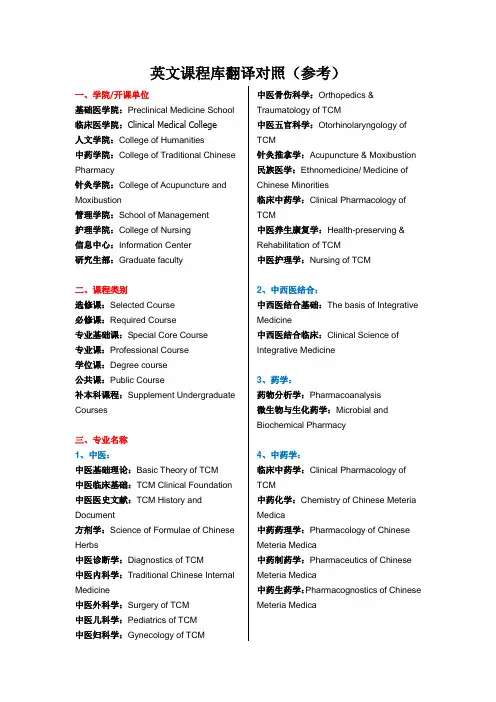
英文课程库翻译对照(参考)一、学院/开课单位基础医学院:Preclinical Medicine School 临床医学院:Clinical Medical College人文学院:College of Humanities中药学院:College of Traditional Chinese Pharmacy针灸学院:College of Acupuncture and Moxibustion管理学院:School of Management护理学院:College of Nursing信息中心:Information Center研究生部:Graduate faculty二、课程类别选修课:Selected Course必修课:Required Course专业基础课:Special Core Course专业课:Professional Course学位课:Degree course公共课:Public Course补本科课程:Supplement Undergraduate Courses三、专业名称1、中医:中医基础理论:Basic Theory of TCM中医临床基础:TCM Clinical Foundation 中医医史文献:TCM History and Document方剂学:Science of Formulae of Chinese Herbs中医诊断学:Diagnostics of TCM中医内科学:Traditional Chinese Internal Medicine中医外科学:Surgery of TCM中医儿科学:Pediatrics of TCM中医妇科学:Gynecology of TCM 中医骨伤科学:Orthopedics & Traumatology of TCM中医五官科学:Otorhinolaryngology of TCM针灸推拿学:Acupuncture & Moxibustion 民族医学:Ethnomedicine/Medicine of Chinese Minorities临床中药学:Clinical Pharmacology of TCM中医养生康复学:Health-preserving& Rehabilitation of TCM中医护理学:Nursing of TCM2、中西医结合:中西医结合基础:The basis of Integrative Medicine中西医结合临床:Clinical Science of Integrative Medicine3、药学:药物分析学:Pharmacoanalysis微生物与生化药学:Microbial and Biochemical Pharmacy4、中药学:临床中药学:Clinical Pharmacology of TCM中药化学:Chemistry of Chinese Meteria Medica中药药理学:Pharmacology of Chinese Meteria Medica中药制药学:Pharmaceutics of Chinese Meteria Medica中药生药学:Pharmacognostics of Chinese Meteria Medica5、公共管理:社会医学与卫生事业管理:Social Medical and Health Service Management四、学位类型科学学位:Science degree临床专业学位:Clinical professional degree五、学位层次:本科学位:Bachelor degree硕士学位:Master's degree博士学位:Doctor's degree/ Ph.D六、课程名称:1、公共课科学社会主义理论:Theories of Scientific Socialism自然辩证法:Nature Dialectics现代科技革命与马克思主义:Modern Science and Technology Revolution and Marxism硕士英语:English for Master’s Degree博士英语:English for Doctor’s Degree博士日语:Japanese for Doctor’s Degree 博士二外英语:Second Foreign Language for Doctor’s Degree (English)计算机应用:Application of Computer医用统计学:Medical Statistics名师大讲堂:Academician Lectures科研思路与方法:Scientific Ideas and Methods/ Research Courses汉语水平考试:HSK博士专业课:Doctor’s Professional Course2、专业课/专基课/选修课/学位课(1)基础医学院课程内经专题讲座:Forums and Lectures of Internal Classic 难经学术思想:Academic Thoughts of NanJing中国古代哲学:Ancient Chinese Philosophy中医基础专论:Monography of Basic TCM Theories伤寒论专题讲座:Treatise on Cold Diseases金匮要略专题讲座:Treatise on Golden Chamber温病学专题讲座:Treatise on Warm Diseases中医训诂考据学:TCM Textology Exegesis 中国医学史:History of TCM中医文献学:Philology of TCM文献检索:Literature Retrieval各家学说:Various Schools of TCM中医医案:Medical Records of TCM中医处方方法学:Prescription Methodology of TCM中医辨证学:TCM Syndrome Differentiation中医诊断古籍选读:Selected ancient readings of TCM Diagnosis中医内科学(中诊专业):Traditional Chinese Internal Medicine临床中药学:Clinical Pharmacology of TCM神经生理学:Neurophysiology生物化学:Biochemistry生物化学实验:Biochemistry Experiment 医学分子生物学:Medical Molecular Biology分子生物学实验:Molecular Biology Experiment实验动物学:Experimental Zoology神经解剖学:Neuroanatomy局部解剖学:Medical Topography头面部局部解剖学:Craniotopography医用细胞学基础:Medical Foundation of Cytology组织细胞分子学实验:Histiocyte Molecular Experiment病理生理学:Pathophysiology医学免疫学:Medical Immunology临床流行病学(DME):Clinical Epidemiology (DME)DME:Design, Measurement and Evaluation中医基础理论(补本科):The Basic Theory of TCM中医养生学概论:Introduction to TCM Health-preserving中医康复学概论:Introduction to TCM Rehabilitation中医饮食营养学:Nutriology of TCM循证医学:Evidence-based Medicine核酸研究技术在中医药学的应用:Application of Nucleic Acid Research Techniques in TCM(2)临床医学院中医内科学专题讲座:Treatises on Traditional Chinese Internal Medicine中医内科杂病研究:Miscellaneous Internal Diseases of TCM中医外科学专题讲座:Treatises on Traditional Chinese Surgery中医妇科学专题讲座:Treatises on TCM Gynecology中医儿科学专题讲座:Treatises on TCM Pediatrics西医内科学:Internal Medicine中西医结合内科学专题讲座:Treatises on Integrative Internal Medicine中西医结合外科学专题讲座:Treatises on Integrative Surgery中西医结合妇科学专题讲座:Treatises on Integrative Gynecology中西医结合五官科学专题讲座:Treatises on Integrative Otorhinolaryngology针灸推拿学专题讲座:Treatises on Acupuncture and Massage中西医结合骨伤科专题讲座:Treatises on Integrative Orthopedics and Traumatology 中西医结合儿科学专题讲座:Treatises on Integrative Pediatrics西医外科学:Surgery临床病理学基础:Basic Theories of Clinical Pathology(3)针灸学院针灸学:Acupuncture中医推拿学:Chinese Massage实验针灸学:Experimental Acupuncture针灸医籍各家学说:Various Schools of Acupuncture masterpieces中医气功学:Qigong of TCM针灸现代研究进展(博士):Modern Research Progress of Acupuncture and Moxibustion针刀疗法:Acupotomology therapy(4)管理学院高级统计学(一):Advanced Statistics(1)卫生经济理论与方法:Health Economic Theory and Method社会医学:Social Medicine现代医院管理:Modern Hospital Management卫生改革与卫生经济政策:Health Reform and Health Economic Policy卫生机构会计实务:Accounting Practice in Health Institution高等教育学:Higher Pedagogy教育管理学:Science of Educational Management药事管理学:Science of Pharmacy Administration药品知识产权实务:Pharmaceutical Intellectual Property Practice高级数据库开发:Advanced Database Development高级网络技术:Advanced Network TechnologyQOL(生存质量)测量与评价:QOL Measurement and Evaluation社会与发展心理学:Social and Developmental Psychology宏微观经济分析:Macro and Micro Economic Analysis现代企业管理:Modern Enterprise Management医院质量与标准化管理:Hospital Quality and Standardized Management财务分析与管理:Financial Analysis and Management高级统计学(二):Advanced Statistics(1)卫生事业管理:Health Service Management流行病学:Epidemiology卫生统计数据库分析与应用:Health Statistics Database Analysis and Application经济法律通论(民法、诉讼法、合同法):General Theory of Economic Laws(Civil law, procedural law and contract law)知识产权法:Intellectual Property Law药品质量管理:Drug Quality Control药事法学:Law of Pharmaceutical Affairs 计算机统计软件应用:Computer statistics software applications 组织行为学:Science of Organizational Behavior人力资源管理:Human Resource Management技术经济学:Technical Economics医药营销:Pharmaceutical Marketing企业战略管理:Enterprise Strategic Management决策支持系统(信息管理):Decision support systems (information management)教育心理学:Education Psychology电子商务:E-commerce项目管理:Project Management古代管理思想研究:Study on Ancient Management Thought论文写作:Essay writing健康教育与健康促进:Health Education and Health Promotion现代管理理论:Modern Management Theory公共关系与危机管理:Public Relations and Crisis Management卫生服务成本研究与应用:Research and Application on Cost of Health Services(5)中药学中药学专论:Monography of Science of Chinese Materia Medica分析测试技术:Analysis and Test Technology中药化学专论:Monography of Chinese Pharmaceutical Chemistry中药药理学专论:Monography of Traditional Chinese Pharmacology中药制药学专论:Monography of Traditional Chinese Pharmaceutics中药生药学专论:Monography ofTraditional Chinese Pharmacognostics临床中药学专论Monography of Clinical Science of Chinese Materia Medica结构有机化学:Structure of Organic Chemistry波谱分析:Spectrum Analysis药性导论:Introduction of Drug Property 本草文献学:Philology of Chinese Materia Medica中医学选读:TCM Selected Readings中药成分分析:Analysis of Chinese Materia Medica Components中药信息学:Informatics of Chinese Materia Medica中药炮制学专论:Monography of Processing Chinese Materia Medica中成药学专论:Monography of Science of Chinese Patent Drug生物药剂学:Biological Pharmacology药用植物学专论:Monography of Medicinal Botany分子生药学:Molecular Pharmacognostics植物化学分类:Classification of Plant Chemistry中药资源学专论:Monography of Chinese Materia Medica Resources中药显微鉴定:Microscopic Identification of Chinese Materia Medica中药品种论述:Chinese Varieties Treatise 中药生物技术:Chinese Biotechnology生物制药专题:Special Subject on Biopharmaceutics药理学进展:Advancements of Pharmacology中药药效毒理研究思路与方法:Research Ideas and methods of Chinese Materia Medica Effect and Toxicology 物理药剂学:Physical Pharmacology科研思路与方法(中药专业) :Scientific ideas and Methods (for Chinese Materia Medica Profession)微生物与生化药学专论:Monography of Microbial and Biochemical Pharmacology 分子细胞生物学专论:Monography of Molecular Cell Biology中药生物技术应用:Biotechnology Applications in Chinese Materia Medica蛋白质工程:Protein Engineering计算机辅助药物设计:Computer-aided drug design微生物与生化药学研究方法:Microbial and Biochemical Pharmaceutical Research Methods药物分析专论:Monography of Drug Analysis药品质量控制:Drug Quality Control中药成分体内代谢与分析:Vivo Metabolism and Analysis of Chinese Materia Medica Components计算药物分析:Analysis of Drug Calculation生物药物分析:Biopharmaceutical Analysis 新药设计学:Science of New Drug Designing中药药理学:Chinese Pharmacology(6)护理学院护理研究进展:Nursing Research Progress 护理理论:Nursing Theory护理教育:Nursing Education中医临床护理概论:Introduction to TCM Clinical Nursing护理心理学:Nursing Psychology本翻译有不尽之处,欢迎各位老师同学提供更好的翻译建议!研究生院培养办。
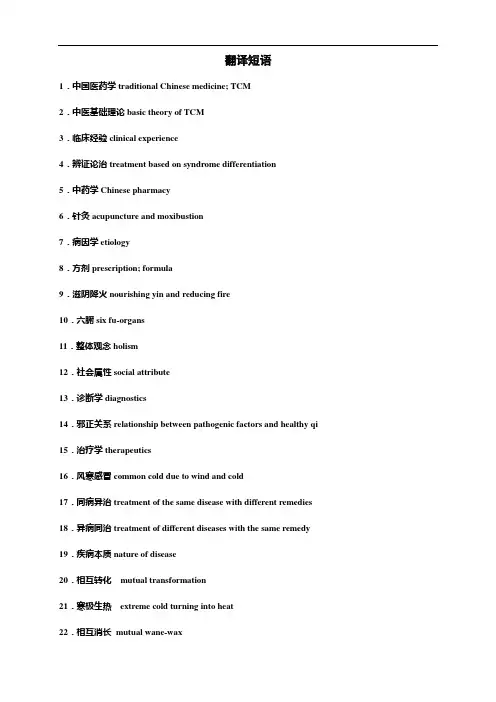
翻译短语1.中国医药学traditional Chinese medicine; TCM2.中医基础理论basic theory of TCM3.临床经验clinical experience4.辨证论治treatment based on syndrome differentiation5.中药学Chinese pharmacy6.针灸acupuncture and moxibustion7.病因学etiology8.方剂prescription; formula9.滋阴降火nourishing yin and reducing fire10.六腑six fu-organs11.整体观念holism12.社会属性social attribute13.诊断学diagnostics14.邪正关系relationship between pathogenic factors and healthy qi 15.治疗学therapeutics16.风寒感冒common cold due to wind and cold17.同病异治treatment of the same disease with different remedies 18.异病同治treatment of different diseases with the same remedy 19.疾病本质nature of disease20.相互转化mutual transformation21.寒极生热extreme cold turning into heat22.相互消长mutual wane-wax23.相互制约mutual restriction24.相互依存interdependence25.五行学说the doctrine of five elements26.相乘相侮subjugation and counter-restriction27.土虚木乘deficient earth being subjugated by wood28.生克制化inhibition-development with generation and restriction 29.母病及子involvement of a child- organ by its mother-organ disorder 30.藏象学说doctrine of visceral manifestations31.奇恒之腑extraordinary fu-organs32.水谷精微essence of water and food33.临床实践clinical practice34.藏而不泻storage without discharge/excretion35.心气充沛sufficiency of heart qi36.血液充盈sufficiency of blood37.汗血同源sweat and blood sharing the same origin38.脾主运化the spleen governing transportation and transformation 39.后天之本origin of acquired constitution40.奇恒之腑extraordinary fu-organs41.上焦upper energizer42.泌别清浊separating the lucid from the turbid43.初步消化primary digestion44.月经来潮occurrence of menstruation45.先天禀赋innateness46.水液代谢water metabolism47.气机调畅smoothness of qi movement48.气机qi movement49.气化qi transformation50.先天之气innate qi51.后天之气acquired qi52.气生血qi generating blood53.气行血qi propelling blood54.津血同源body fluid and blood sharing the same origin55.气为血帅,血为气母Qi serves as commander of blood and blood does as mother of qi 56.益气固脱nourishing qi to stop collapse57.经络学说meridian theory58.经络系统meridian system59.十二正经twelve regular meridians60.奇经八脉eight extraordinary meridians61.十二经别twelve meridians’divergences62.外感六淫six exogenous pathogenic factors63.风邪外袭pathogenic wind attacking the exterior64.感受寒邪attack/invade by pathogenic cold65.阴虚生内热production of endogenous heat due to yin deficiency66.七情内伤internal impairment due to seven emotions67.体质强弱(body )constitutional state68.五心烦热feverish sensation in the five centers (palms, soles, and chest)69.五志过极extreme changes of five emotions70.阴阳互损mutual involvement of yin and yang71.精充气足sufficient essence and abundant qi72.肌肤甲错squamous and dry skin73.预后良好favorable prognosis74.脉象pulse conations75.表里同病disease involving both exterior and interior76.寒热错杂co-existence of cold and heat/ mixture of cold and heat 77.真寒假热true cold with false heat78.寒证化热cold syndrome transforming into heat one79.热证转寒transformation of heat syndrome into cold one 80.潮热盗汗tidal fever and night sweating81.中草药Chinese medicinal herbs82.四气五味four properties and five flavors83.燥湿健脾drying dampness to invigorate the spleen84.升降沉浮ascending, descending, sinking and floating85.归经channel tropism of medicines86.用药禁忌medication contraindication87.方剂学science of prescription88.方剂的加减modification of a prescription89.剂型与剂量drug form and dosage90.药物毒性toxicity of medicinal herb91.引经报使guiding action92.药物饮片herbal slice93.针灸疗法acupuncture and moxibustion (therapy)94.针刺补泻reinforcing and reducing95针刺止痛analgesia by acupuncture96.针刺麻醉acupuncture anesthesia97.耳针疗法ear acupuncture (therapy)98.提插捻转lifting, thrusting, twisting and rotating (techniques)翻译句子1.中国医药学有数千年的历史,是中国人民长期同疾病作斗争的经验总结。
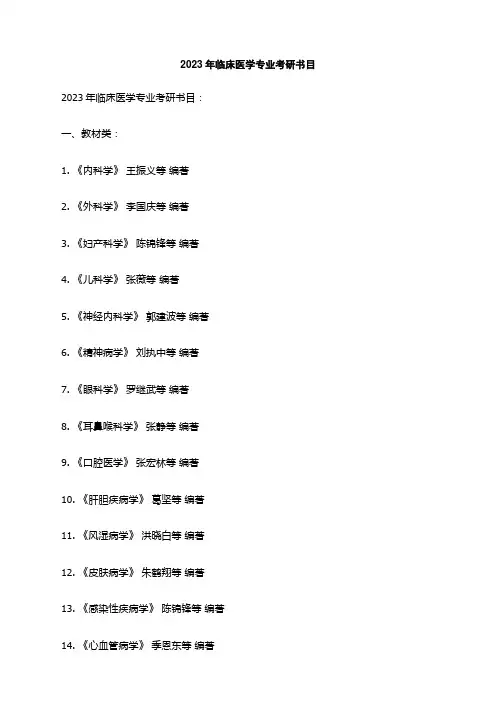
2023年临床医学专业考研书目2023年临床医学专业考研书目:
一、教材类:
1. 《内科学》王振义等编著
2. 《外科学》李国庆等编著
3. 《妇产科学》陈锦锋等编著
4. 《儿科学》张薇等编著
5. 《神经内科学》郭建波等编著
6. 《精神病学》刘执中等编著
7. 《眼科学》罗继武等编著
8. 《耳鼻喉科学》张静等编著
9. 《口腔医学》张宏林等编著
10. 《肝胆疾病学》葛坚等编著
11. 《风湿病学》洪晓白等编著
12. 《皮肤病学》朱鹤翔等编著
13. 《感染性疾病学》陈锦锋等编著
14. 《心血管病学》季恩东等编著
15. 《内分泌学》李建华等编著
16. 《肿瘤学》杨建侠等编著
二、参考书类:
1. 《临床诊断学》
2. 《实用医学统计学》
3. 《临床流行病学》
4. 《医学伦理学》
5. 《医学英语》
6. 《医学文献检索》
7. 《临床表现与诊断》
8. 《临床治疗学》
9. 《疑难病例集》
10. 《检验诊断学》
11. 《医学影像学》
12. 《医学新技术与诊断》
13. 《医学影像诊断技术与临床应用》
14. 《现代医学实验技术与临床应用》
以上是2023年临床医学专业考研书目,同学们参考一下。
在考研备考时,根据自己的建议重点买教材,配合参考书进行深入学习。
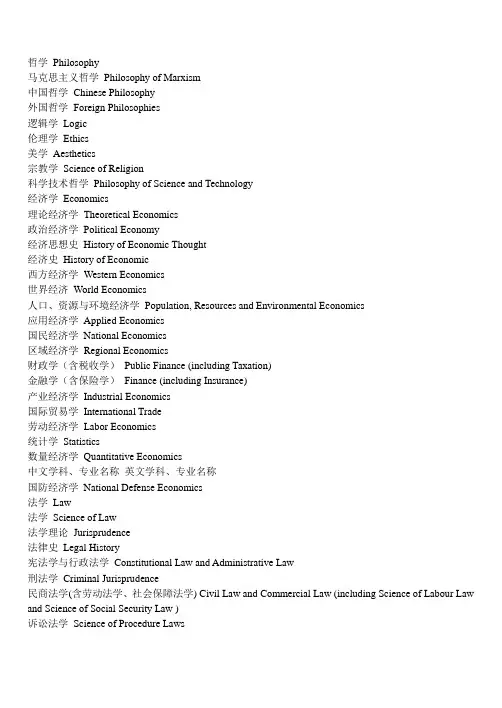
哲学Philosophy马克思主义哲学Philosophy of Marxism中国哲学Chinese Philosophy外国哲学Foreign Philosophies逻辑学Logic伦理学Ethics美学Aesthetics宗教学Science of Religion科学技术哲学Philosophy of Science and Technology经济学Economics理论经济学Theoretical Economics政治经济学Political Economy经济思想史History of Economic Thought经济史History of Economic西方经济学Western Economics世界经济World Economics人口、资源与环境经济学Population, Resources and Environmental Economics应用经济学Applied Economics国民经济学National Economics区域经济学Regional Economics财政学(含税收学)Public Finance (including Taxation)金融学(含保险学)Finance (including Insurance)产业经济学Industrial Economics国际贸易学International Trade劳动经济学Labor Economics统计学Statistics数量经济学Quantitative Economics中文学科、专业名称英文学科、专业名称国防经济学National Defense Economics法学Law法学Science of Law法学理论Jurisprudence法律史Legal History宪法学与行政法学Constitutional Law and Administrative Law刑法学Criminal Jurisprudence民商法学(含劳动法学、社会保障法学) Civil Law and Commercial Law (including Science of Labour Law and Science of Social Security Law )诉讼法学Science of Procedure Laws经济法学Science of Economic Law环境与资源保护法学Science of Environment and Natural Resources Protection Law国际法学(含国际公法学、国际私法学、国际经济法学、) International law (including International Public law, International Private Law and International Economic Law)军事法学Science of Military Law政治学Political Science政治学理论Political Theory中外政治制度Chinese and Foreign Political Institution科学社会主义与国际共产主义运动Scientific Socialism and InternationalCommunist Movement中共党史(含党的学说与党的建设) History of the Communist Party of China(including the Doctrine of China Party and Party Building)马克思主义理论与思想政治教育Education of Marxist Theory and Education in Ideology and Politics国际政治学International Politics国际关系学International Relations外交学Diplomacy社会学Sociology社会学Sociology人口学Demography人类学Anthropology民俗学(含中国民间文学) Folklore (including Chinese Folk Literature)民族学Ethnology民族学Ethnology马克思主义民族理论与政策Marxist Ethnic Theory and Policy中国少数民族经济Chinese Ethnic Economics中国少数民族史Chinese Ethnic History中国少数民族艺术Chinese Ethnic Art教育学Education教育学Education Science教育学原理Educational Principle课程与教学论Curriculum and Teaching Methodology教育史History of Education比较教育学Comparative Education学前教育学Pre-school Education高等教育学Higher Education成人教育学Adult Education职业技术教育学V ocational and Technical Education特殊教育学Special Education教育技术学Education Technology心理学Psychology基础心理学Basic Psychology发展与心理学Developmental and Educational Psychology应用心理学Applied Psychology体育学Science of Physical Culture and Sports体育人文社会学Humane and Sociological Science of Sports运动人体科学Human Movement Science体育教育训练学Theory of Sports Pedagogy and Training民族传统体育学Science of Ethnic Traditional Sports文学Literature中国语言文学Chinese Literature文艺学Theory of Literature and Art语言学及应用语言学Linguistics and Applied Linguistics汉语言文字学Chinese Philology中国古典文献学Study of Chinese Classical Text中国古代文学Ancient Chinese Literature中国现当代文学Modern and Contemporary Chinese Literature中国少数民族语言文学Chinese Ethnic Language and Literature比较文学与世界文学Comparative Literature and World Literature 外国语言文学Foreign Languages and Literatures英语语言文学English Language and Literature俄语语言文学Russian Language and Literature法语语言文学French Language and Literature德语语言文学German Language and Literature日语语言文学Japanese Language and Literature印度语言文学Indian Language and Literature西班牙语语言文学Spanish Language and Literature阿拉伯语语言文学Arabic Language and Literature欧洲语言文学European Language and Literature亚非语言文学Asian-African Language and Literature外国语言学及应用语言学Linguistics and Applied Linguistics in Foreign Languages新闻传播学Journalism and Communication新闻学Journalism传播学Communication艺术学Art艺术学Art Theory音乐学Music美术学Fine Arts设计艺术学Artistic Design戏剧戏曲学Theater and Chinese Traditional Opera电影学Film广播电视艺术学Radio and television Art舞蹈学Dance历史学History历史学History史学理论及史学史Historical Theories and History of Historical Science考古学及博物馆学Archaeology and Museology历史地理学Historical Geography历史文献学(含敦煌学、古文字学) Studies of Historical Literature (including Paleography and Studies of Dunhuang)专门史History of Particular Subjects中国古代史Ancient Chinese History中国近现代史Modern and Contemporary Chinese History世界史World History理学Natural Science数学Mathematics基础数学Fundamental Mathematics计算数学Computational Mathematics概率论与数理统计Probability and Mathematical Statistics应用数学Applied mathematics运筹学与控制论Operational Research and Cybernetics物理学Physics理论物理Theoretical Physics粒子物理与原子核物理Particle Physics and Nuclear Physics原子与分子物理Atomic and Molecular Physics等离子体物理Plasma Physics凝聚态物理Condensed Matter Physics声学Acoustics光学Optics无线电物理Radio Physics化学Chemistry无机化学Inorganic Chemistry分析化学Analytical Chemistry有机化学Organic Chemistry物理化学(含化学物理)Physical Chemistry (including Chemical Physics) 高分子化学与物理Chemistry and Physics of Polymers天文学Astronomy天体物理Astrophysics天体测量与天体力学Astrometry and Celestial Mechanics地理学Geography自然地理学Physical Geography人文地理学Human Geography地图学与地理信息系统Cartography and Geography Information System大气科学Atmospheric Sciences气象学Meteorology大气物理学与大气环境Atmospheric Physics and Atmospheric Environment 海洋科学Marine Sciences物理海洋学Physical Oceanography海洋化学Marine Chemistry海洋生理学Marine Biology海洋地质学Marine Geology地球物理学Geophysics固体地球物理学Solid Earth Physics空间物理学Space Physics地质学Geology矿物学、岩石学、矿床学Mineralogy, Petrology, Mineral Deposit Geology 地球化学Geochemistry古生物学与地层学(含古人类学)Paleontology and Stratigraphy (including Paleoanthropology)构造地质学Structural Geology第四纪地质学Quaternary Geology生物学Biology植物学Botany动物学Zoology生理学Physiology水生生物学Hydrobiology微生物学Microbiology神经生物学Neurobiology遗传学Genetics发育生物学Developmental Biology细胞生物学Cell Biology生物化学与分子生物学Biochemistry and Molecular Biology生物物理学Biophysics生态学Ecology系统科学Systems Science系统理论Systems Theory系统分析与集成Systems Analysis and Integration科学技术史History of Science and Technology工学Engineering力学Mechanics一般力学与力学基础General and Fundamental Mechanics固体力学Solid Mechanics流体力学Fluid Mechanics工程力学Engineering Mechanics机械工程Mechanical Engineering机械制造及其自动化Mechanical Manufacture and Automation机械电子工程Mechatronic Engineering机械设计与理论Mechanical Design and Theory车辆工程Vehicle Engineering光学工程Optical Engineering仪器科学与技术Instrument Science and Technology精密仪器及机械Precision Instrument and Machinery测试计量技术及仪器Measuring and Testing Technologies and Instruments 材料科学与工程Materials Science and Engineering材料物理与化学Materials Physics and Chemistry材料学Materialogy材料加工工程Materials Processing Engineering冶金工程Metallurgical Engineering冶金物理化学Physical Chemistry of Metallurgy钢铁冶金Ferrous Metallurgy有色金属冶金Non-ferrous Metallurgy动力工程及工程热物理Power Engineering and Engineering Thermophysics 工程热物理Engineering Thermophysics热能工程Thermal Power Engineering动力机械及工程Power Machinery and Engineering流体机械及工程Fluid Machinery and Engineering制冷及低温工程Refrigeration and Cryogenic Engineering化工过程机械Chemical Process Equipment电气工程Electrical Engineering电机与电器Electric Machines and Electric Apparatus电力系统及其自动化Power System and its Automation高电压与绝缘技术High V oltage and Insulation Technology电力电子与电力传动Power Electronics and Power Drives电工理论与新技术Theory and New Technology of Electrical Engineering电子科学与技术Electronics Science and Technology物理电子学Physical Electronics电路与系统Circuits and Systems微电子学与固体电子学Microelectronics and Solid State Electronics电磁场与微波技术Electromagnetic Field and Microwave Technology信息与通信工程Information and Communication Engineering通信与信息系统Communication and Information Systems信号与信息处理Signal and Information Processing控制科学与工程Control Science and Engineering控制理论与控制工程Control Theory and Control Engineering检测技术与自动化装置Detection Technology and Automatic Equipment系统工程Systems Engineering模式识别与智能系统Pattern Recognition and Intelligent Systems导航、制导与控制Navigation, Guidance and Control计算机科学与技术Computer Science and Technology计算机软件与理论Computer Software and Theory计算机系统结构Computer Systems Organization计算机应用技术Computer Applied Technology建筑学Architecture建筑历史与理论Architectural History and Theory建筑设计及其理论Architectural Design and Theory城市规划与设计(含风景园林规划与设计)Urban Planning and Design (including Landscape Planning and Design)建筑技术科学Building Technology Science土木工程Civil Engineering岩土工程Geotechnical Engineering结构工程Structural Engineering市政工程Municipal Engineering供热、供燃气、通风及空调工程Heating, Gas Supply, Ventilating and Air Conditioning Engineering防灾减灾工程及防护工程Disaster Prevention and Reduction Engineering and Protective Engineering桥梁与隧道工程Bridge and Tunnel Engineering水利工程Hydraulic Engineering水文学及水资源Hydrology and Water Resources水力学及河流动力学Hydraulics and River Dynamics水工结构工程Hydraulic Structure Engineering水利水电工程Hydraulic and Hydro-Power Engineering港口、海岸及近海工程Harbor, Coastal and Offshore Engineering测绘科学与技术Surveying and Mapping大地测量学与测量工程Geodesy and Survey Engineering摄影测量与遥感Photogrammetry and Remote Sensing地图制图学与地理信息工程Cartography and Geographic Information Engineering 化学工程与技术Chemical Engineering and Technology化学工程Chemical Engineering化学工艺Chemical Technology生物化工Biochemical Engineering应用化学Applied Chemistry工业催化Industrial Catalysis地质资源与地质工程Geological Resources and Geological Engineering矿产普查与勘探Mineral Resource Prospecting and Exploration地球探测与信息技术Geodetection and Information Technology地质工程Geological Engineering矿业工程Mineral Engineering采矿工程Mining Engineering矿物加工工程Mineral Processing Engineering安全技术及工程Safety Technology and Engineering石油与天然气工程Oil and Natural Gas Engineering油气井工程Oil-Gas Well Engineering油气田开发工程Oil-Gas Field Development Engineering油气储运工程Oil-Gas Storage and Transportation Engineering纺织科学与工程Textile Science and Engineering纺织工程Textile Engineering纺织材料与纺织品设计Textile Material and Textiles Design纺织化学与染整工程Textile Chemistry and Dyeing and Finishing Engineering服装设计与工程Clothing Design and Engineering轻工技术与工程The Light Industry Technology and Engineering制浆造纸工程Pulp and Paper Engineering制糖工程Sugar Engineering发酵工程Fermentation Engineering皮革化学与工程Leather Chemistry and Engineering交通运输工程Communication and Transportation Engineering道路与铁道工程Highway and Railway Engineering交通信息工程及控制Traffic Information Engineering & Control交通运输规划与管理Transportation Planning and Management载运工具运用工程Vehicle Operation Engineering船舶与海洋工程Naval Architecture and Ocean Engineering船舶与海洋结构物设计制造Design and Construction of Naval Architecture and Ocean Structure 轮机工程Marine Engine Engineering水声工程Underwater Acoustics Engineering航空宇航科学与技术Aeronautical and Astronautical Science and Technology飞行器设计Flight Vehicle Design航空宇航推进理论与工程Aerospace Propulsion Theory and Engineering航空宇航器制造工程Manufacturing Engineering of Aerospace Vehicle人机与环境工程Man-Machine and Environmental Engineering兵器科学与技术Armament Science and Technology武器系统与运用工程Weapon Systems and Utilization Engineering兵器发射理论与技术Armament Launch Theory and Technology火炮、自动武器与弹药工程Artillery, Automatic Gun and Ammunition Engineering军事化学与烟火技术Military Chemistry and Pyrotechnics核科学与技术Nuclear Science and Technology核能科学与工程Nuclear Energy Science and Engineering核燃料循环与材料Nuclear Fuel Cycle and Materials核技术及应用Nuclear Technology and Applications辐射防护及环境保护Radiation and Environmental Protection农业工程Agricultural Engineering农业机械化工程Agricultural Mechanization Engineering农业水土工程Agricultural Water-Soil Engineering农业生物环境与能源工程Agricultural Biological Environmental and Energy Engineering农业电气化与自动化Agricultural Electrification and Automation林业工程Forestry Engineering森林工程Forest Engineering木材科学与技术Wood Science and Technology林产化学加工工程Chemical Processing Engineering of Forest Products环境科学与工程Environmental Science and Engineering环境科学Environmental Science环境工程Environmental Engineering生物医学工程Biomedical Engineering食品科学与工程Food Science and Engineering食品科学Food Science粮食、油脂及植物蛋白工程Cereals, Oils and Vegetable Protein Engineering农产品加工及贮藏工程Processing and Storage of Agriculture Products水产品加工及贮藏工程Processing and Storage of Aquatic Products农学Agriculture作物学Crop Science作物栽培学与耕作学Crop Cultivation and Farming System作物遗传育种学Crop Genetics and Breeding园艺学Horticulture果树学Pomology蔬菜学Olericulture茶学Tea Science农业资源利用学Utilization Science of Agricultural Resources土壤学Soil Science植物营养学Plant Nutrition植物保护学Plant Protection植物病理学Plant Pathology农业昆虫与害虫防治Agricultural Entomology and Pest Control农药学Pesticide Science畜牧学Animal Science动物遗传育种与繁殖Animal Genetics, Breeding and ReproductionScience动物营养与饲料科学Animal Nutrition and Feed Science草业科学Practaculture Science特种经济动物饲养学(含蚕、蜂等)The Rearing of Special-type Economic Animals (including Silkworm, Honeybees, etc.)兽医学Veterinary Medicine基础兽医学Basic Veterinary Medicine预防兽医学Preventive Veterinary Medicine临床兽医学Clinical Veterinary Medicine林学Forestry林木遗传育种学Forest Tree Genetics and Breeding森林培育学Silviculture森林保护学Forest Protection森林经理学Forest Management野生动植物保护与利用Wildlife Conservation and Utilization园林植物与观赏园艺Ornamental Plants and Horticulture水土保持与荒漠化防治Soil and Water Conservation and Desertification Combating 水产学Fisheries Science水产养殖学Aquaculture Science捕捞学Fishing Science渔业资源学Science of Fisheries Resources医学Medicine基础医学Basic Medicine人体解剖与组织胚胎学Human Anatomy, Histology and Embryology免疫学Immunology病原生物学Pathogenic Organisms病理学与病理生理学Pathology and Pathophysiology法医学Forensic Medicine放射医学Radiation Medicine航空航天与航海医学Aerospace and Nautical medicine临床医学Clinical Medicine内科学(含心血管病学、血液病学、呼吸系病学、消化系病学、内分泌与代谢病学、肾脏病学、风湿病学、传染病学)Internal medicine (including Cardiology, Hematology, Respiratory, Gastroenterology, Endocrinology and Metabolism, Nephrology, Rheuma-tology, Infectious Diseases)儿科学Pediatrics老年医学Geriatrics神经病学Neurology精神病与精神卫生学Psychiatry and Mental Health皮肤病与性病学Dermatology and Venereology影像医学与核医学Imaging and Nuclear Medicine临床检验诊断学Clinical Laboratory Diagnostics护理学Nursing外科学(含普通外科学、骨外科学、泌尿外科学、胸心血管外科学、神经外科学、整形外科学、烧伤外科学、野战外科学)Surgery (General Surgery, Orthopedics, Urology, Cardiothoracic Surgery, Neurosurgery, Plastic Surgery, Burn Surgery, Field Surgery)妇产科学Obstetrics and Gynecology眼科学Ophthalmic Specialty耳鼻咽喉科学Otolaryngology肿瘤学Oncology康复医学与理疗学Rehabilitation Medicine & Physical Therapy运动医学Sports Medicine麻醉学Anesthesiology急诊医学Emergency Medicine口腔医学Stomatology口腔基础医学Basic Science of Stomatology口腔临床医学Clinical Science of Stomatology公共卫生与预防医学Public Health and Preventive Medicine流行病与卫生统计学Epidemiology and Health Statistics劳动卫生与环境卫生学Occupational and Environmental Health营养与食品卫生学Nutrition and Food Hygiene儿少卫生与妇幼保健学Maternal, Child and Adolescent Health卫生毒理学Hygiene Toxicology军事预防医学Military Preventive Medicine中医学Chinese Medicine中医基础理论Basic Theories of Chinese Medicine中医临床基础Clinical Foundation of Chinese Medicine中医医史文献History and Literature of Chinese Medicine方剂学Formulas of Chinese Medicine中医诊断学Diagnostics of Chinese Medicine中医内科学Chinese Internal Medicine中医外科学Surgery of Chinese Medicine中医骨伤科学Orthopedics of Chinese Medicine中医妇科学Gynecology of Chinese Medicine中医儿科学Pediatrics of Chinese Medicine中医五官科学Ophthalmology and Otolaryngoloy of Chinese Medicine针灸推拿学Acupuncture and Moxibustion and Tuina of Chinese medicine民族医学Ethnomedicine中西医结合医学Chinese and Western Integrative Medicine中西医结合基础医学Basic Discipline of Chinese and Western Integrative中西医结合临床医学Clinical Discipline of Chinese and Western Integrative Medicine 药学Pharmaceutical Science药物化学Medicinal Chemistry药剂学Pharmaceutics生药学Pharmacognosy药物分析学Pharmaceutical Analysis微生物与生化药学Microbial and Biochemical Pharmacy药理学Pharmacology中药学Science of Chinese Pharmacology军事学Military Science军事思想学及军事历史学Military Thought and Military History军事思想学Military Thought军事历史学Military History战略学Science of Strategy军事战略学Military Strategy战争动员学War Mobilization战役学Science of Operations联合战役学Joint Operation军种战役学(含第二炮兵战役学)Armed Service Operation (including Operation of Strategic Missile Force)战术学Science of Tactics合同战术学Combined-Arms Tactics兵种战术学Branch Tactics军队指挥学Science of Command作战指挥学Combat Command军事运筹学Military Operation Research军事通信学Military Communication军事情报学Military Intelligence密码学Cryptography军事教育训练学(含军事体育学)Military Education and Training (including Military Physical Training)军制学Science of Military System军事组织编制学Military Organizational System军队管理学Military Management军队政治工作学Science of Military Political Work军事后勤学与军事装备学Science of Military Logistics and Military Equipment军事后勤学Military Logistics后方专业勤务Rear Special Service军事装备学Military Equipment管理学Management Science管理科学与工程Management Science and Engineering工商管理学Science of Business Administration会计学Accounting企业管理学(含财务管理、市场营销学、人力资源管理学)Corporate Management (including Financial Management, Marketing, and Human Resources Management)旅游管理学Tourist Management技术经济及管理学Technology Economy and Management农林经济管理学Agricultural and Forestry Economics & Management农业经济管理学Agricultural Economics & Management林业经济管理学Forestry Economics & Management公共管理学Science of Public Management行政管理学Administration Management社会医学与卫生事业管理学Social Medicine and Health Management教育经济与管理学Educational Economy and Management社会保障学Social Security土地资源管理学Land Resource Management图书馆、情报与档案学Science of Library, Information and Archival 图书馆学Library Science情报学Information Science档案学Archival Science。
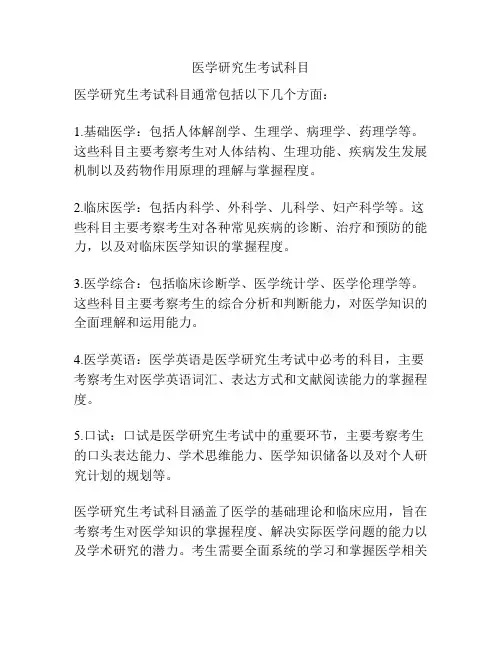
医学研究生考试科目
医学研究生考试科目通常包括以下几个方面:
1.基础医学:包括人体解剖学、生理学、病理学、药理学等。
这些科目主要考察考生对人体结构、生理功能、疾病发生发展机制以及药物作用原理的理解与掌握程度。
2.临床医学:包括内科学、外科学、儿科学、妇产科学等。
这些科目主要考察考生对各种常见疾病的诊断、治疗和预防的能力,以及对临床医学知识的掌握程度。
3.医学综合:包括临床诊断学、医学统计学、医学伦理学等。
这些科目主要考察考生的综合分析和判断能力,对医学知识的全面理解和运用能力。
4.医学英语:医学英语是医学研究生考试中必考的科目,主要考察考生对医学英语词汇、表达方式和文献阅读能力的掌握程度。
5.口试:口试是医学研究生考试中的重要环节,主要考察考生的口头表达能力、学术思维能力、医学知识储备以及对个人研究计划的规划等。
医学研究生考试科目涵盖了医学的基础理论和临床应用,旨在考察考生对医学知识的掌握程度、解决实际医学问题的能力以及学术研究的潜力。
考生需要全面系统的学习和掌握医学相关
知识,并注重实践和动手能力的培养,以便在医学研究生考试中取得好的成绩。
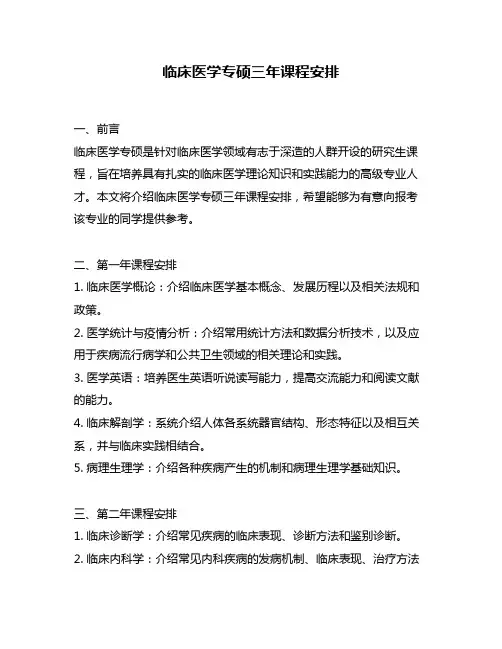
临床医学专硕三年课程安排一、前言临床医学专硕是针对临床医学领域有志于深造的人群开设的研究生课程,旨在培养具有扎实的临床医学理论知识和实践能力的高级专业人才。
本文将介绍临床医学专硕三年课程安排,希望能够为有意向报考该专业的同学提供参考。
二、第一年课程安排1. 临床医学概论:介绍临床医学基本概念、发展历程以及相关法规和政策。
2. 医学统计与疫情分析:介绍常用统计方法和数据分析技术,以及应用于疾病流行病学和公共卫生领域的相关理论和实践。
3. 医学英语:培养医生英语听说读写能力,提高交流能力和阅读文献的能力。
4. 临床解剖学:系统介绍人体各系统器官结构、形态特征以及相互关系,并与临床实践相结合。
5. 病理生理学:介绍各种疾病产生的机制和病理生理学基础知识。
三、第二年课程安排1. 临床诊断学:介绍常见疾病的临床表现、诊断方法和鉴别诊断。
2. 临床内科学:介绍常见内科疾病的发病机制、临床表现、治疗方法等方面的知识。
3. 临床外科学:介绍常见外科疾病的发病机制、临床表现、手术治疗等方面的知识。
4. 临床影像学:介绍各种影像技术在临床医学中的应用,如X线、CT、MRI等。
5. 神经系统疾病:介绍神经系统常见疾病的发生机制、临床表现和治疗方法。
四、第三年课程安排1. 儿科学:介绍儿科常见疾病的发生机制、预防措施和治疗方法。
2. 妇产科学:介绍妇产科常见问题,如孕期保健、分娩方式选择等。
3. 肿瘤学:介绍肿瘤发生机制以及各种治疗方法,如手术、放疗、化疗等。
4. 临床药理学:介绍各类药物的作用机制、临床应用和不良反应等方面的知识。
5. 临床实践:开展实际的临床实践活动,提高学生的实际操作能力和综合素质。
五、结语以上是临床医学专硕三年课程安排的详细介绍。
通过这些课程学习,学生将掌握扎实的医学理论知识和实践能力,为日后从事临床工作打下坚实基础。
当然,具体课程设置可能会因不同院校而有所不同,希望有意向报考该专业的同学可以根据自己的情况进行选择。
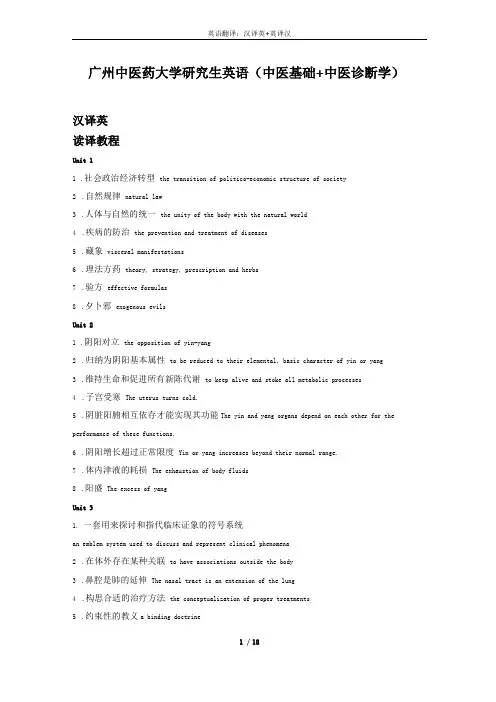
广州中医药大学研究生英语(中医基础+中医诊断学)汉译英读译教程Unit 11.社会政治经济转型the transition of politico-economic structure of society2.自然规律natural law3.人体与自然的统一the unity of the body with the natural world4.疾病的防治the prevention and treatment of diseases5.藏象visceral manifestations6.理法方药theory, strategy, prescription and herbs7.验方effective formulas8.夕卜邪exogenous evilsUnit 21.阴阳对立the opposition of yin-yang2.归纳为阴阳基本属性to be reduced to their elemental, basic character of yin or yang3.维持生命和促进所有新陈代谢to keep alive and stoke all metabolic processes4.子宫受寒The uterus turns cold.5.阴脏阳腑相互依存才能实现其功能The yin and yang organs depend on each other for the performance of these functions.6.阴阳增长超过正常限度Yin or yang increases beyond their normal range.7.体内津液的耗损The exhaustion of body fluids8.阳盛The excess of yangUnit 31.一套用来探讨和指代临床证象的符号系统an emblem system used to discuss and represent clinical phenomena2.在体外存在某种关联to have associations outside the body3.鼻腔是肺的延伸The nasal tract is an extension of the lung4.构思合适的治疗方法the conceptualization of proper treatments5.约束性的教义a binding doctrine1 / 186.虚证the pattern of deficiency7.子盗母气The child steals the qi of the mother.8.相生the mutual generation order9.相侮the counter-control cycleUnit 41.多重性质the multidimensional nature2.从解剖学和生理学角度理解to be viewed from the perspective of anatomy and physiology3.先天之气和后天之气the prenatal and postnatal qi4.气与气之间的转化the transformation of one type of qi into another5.调控毛孔的开合in charge of opening and closing our pores6.元气the original qi7.保证血液行于脉内而不至外溢to keep blood within the vessels8.防御外邪侵袭身体to defend the body from external pathogenic factorsUnit 51.心主血脉The heart governs the blood and vessels.2.肃降depurative downbearing3.控制汗孔开阖和抵御外邪入侵To control the opening and closing of sweat pores and to defend the exterior against invading evils4.消化和吸收功能the functions of digestion and assimilation5.水谷精微the essence of grain and wafer6.肝开窍于目The liver opens at the eyes.7.肾藏精The kidney stores essence.8.一身阴阳之本the root of yin and yang of the whole bodyUnit 71.望、闻、问、切inspection, listening and smelling, inquiry, palpation2.望全身情况(神、色、形、态)the observation of the entire body (spirit, color, form, bearing)3.声音低弱The voice is faint and low.4.听语言listening to speech5.脏腑衰败的凶险证inauspicious omen of the vanquished debility of the zang-fu organs6.问妇女经、带等问题inquiry of women problems such as menstrual cycle and vaginal英语翻译:汉译英+英译汉discharge7.解除病人顾虑to relieve the patients' apprehensions8.压痛tendernessUnit 81.六淫和七情the six pernicious influences and the seven emotions2.行动迟缓笨拙slow and awkward motion3.怕冷 a fear of cold4.蜷臣卜to sleep in a curled-up position5.中医把人作为一个整体看待Chinese medicine views the human being as a whole.6.慢性病 a chronic condition7.止渴to quench one's thirst8.关节僵硬stiff joint(s)诊断英语Unitl1.舌象the appearance of the tongue2.舌苔小块剥落the tongue becomes peeled in patches/the coating falls off in small areas3.长年累月的使用prolonged use over some years4.糟粕unclean residue5.不受诸如身体劳累、情绪低落等短暂生理情志因素的影响Irrespective of temporary conditions such as those resulting from recent physical exertion or emotional upset6.水液积聚accumulation of body fluids7.色泽荣润vibrant and vital color8.心开窍于舌The tongue is regarded as the offshoot of the heart.Unit 21.心藏神The heart houses the mind and spirit.2.发声短促尖锐emit voice in short, sharp bursts3.“歌”声音调较高,音律优美、高低起伏,有如歌唱。
医学Medicine基础医学Basic Medicine人体解剖与组织胚胎学Human Anatomy, Histology and Embryology免疫学Immunology病原生物学Pathogenic Organisms病理学与病理生理学Pathology and Pathophysiology法医学Forensic Medicine/Science放射医学Radiation Medicine航空航天与航海医学Aerospace and Nautical medicine临床医学Clinical Medicine内科学(含心血管病学、血液病学、呼吸系病学、消化系病学、内分泌与代谢病学、肾脏病学、风湿病学、传染病学)Internal medicine (including Cardiology, Hematology, Respiratory, Gastroenterology,Endocrinology and Metabolism, Nephrology,Rheuma-tology, Infectious Diseases)儿科学Pediatrics老年医学Geriatrics神经病学Neurology精神病与精神卫生学Psychiatry and Mental Health皮肤病与性病学Dermatology and Venereology影像医学与核医学Imaging and Nuclear Medicine临床检验诊断学Clinical Laboratory Diagnostics护理学Nursing外科学(含普通外科学、骨外科学、泌尿外科学、胸心血管外科学、神经外科学、整形外科学、烧伤外科学、野战外科学)Surgery (General Surgery, Orthopedics, Urology, Cardiothoracic Surgery, Neurosurgery, Plastic Surgery, Burn Surgery, Field Surgery)妇产科学Obstetrics and Gynecology眼科学Ophthalmic Specialty耳鼻咽喉科学Otolaryngology肿瘤学Oncology康复医学与理疗学Rehabilitation Medicine & Physical Therapy运动医学Sports Medicine麻醉学Anesthesiology急诊医学Emergency Medicine口腔医学Stomatology口腔基础医学Basic Science of Stomatology口腔临床医学Clinical Science of Stomatology公共卫生与预防医学Public Health and Preventive Medicine流行病与卫生统计学Epidemiology and Health Statistics劳动卫生与环境卫生学Occupational and Environmental Health营养与食品卫生学Nutrition and Food Hygiene少儿卫生与妇幼保健学Maternal, Child and Adolescent Health卫生毒理学Hygiene Toxicology军事预防医学Military Preventive Medicine中医学Chinese Medicine中医基础理论Basic Theories of Chinese Medicine中医临床基础Clinical Foundation of Chinese Medicine中医医史文献History and Literature of Chinese Medicine方剂学Formulas of Chinese Medicine中医诊断学Diagnostics of Chinese Medicine中医内科学Chinese Internal Medicine中医外科学Surgery of Chinese Medicine中医骨伤科学Orthopedics of Chinese Medicine中医妇科学Gynecology of Chinese Medicine中医儿科学Pediatrics of Chinese Medicine中医五官科学Ophthalmology and Otolaryngoloy of Chinese Medicine针灸推拿学Acupuncture and Moxibustion and Tuina of Chinese medicine民族医学Ethnomedicine中西医结合医学Chinese and Western Integrative Medicine中西医结合基础医学Basic Discipline of Chinese and Western Integrative中西医结合临床医学Clinical Discipline of Chinese and Western Integrative Medicine药学Pharmaceutical Science药物化学Medicinal Chemistry药剂学Pharmaceutics生药学Pharmacognosy药物分析学Pharmaceutical Analysis微生物与生化药学Microbial and Biochemical Pharmacy药理学Pharmacology中药学Science of Chinese Pharmacology。
上海交通大学医学院诊断学双语教材Clinical Diagnostics(临床诊断学)仁济临床医学院诊断学教研室An Introduction to Clinical Diagnostics After you finish your premedical courses, you are now going to touch patients. The clinical diagnosis serves as a bridge between premedical and clinical medicine. It includes physical diagnosis, Laboratory diagnosis and some instrumental examination. Formerly these are taught separately but now our country they are combined to form one course, which is now called clinical diagnosis.The medical students are the physicians of tomorrow, and as such, you need information from every source to unravel the my stery of the patients’ illness. Physical diagnosis deals with such information through the two most fundamental skills, the interrogation and physical examination.Interrogation means to get the history in detail of a patient’s illness and the best way as to let the patient tell his story in his own. As some crucial points might be overlooked by the patients, you will ask many searching questions to make the history complete and more informative.Occasionally a patient will not or cannot give a straight story, you may interrogate his (her)family members or friends to get more information date.The next step is then to do a physical examination. The body of the patient will be examined meticulously in every way possible by you, using all of your five senses. A physical examination usually includes inspection, palpation, percussion, and auscultation. Here our ancient doctors had given great contributions. Almost two thousand years ago they had developed inspection, interrogation, smell and pulse palpation to make diagnosis and develop many syndromes which are still useful clinically today. After that you can make a preliminary analysis, correlating the history with positive physical signs, determining the organs involved and even set down a preliminary diagnosis, which we usually call it an impression but not a definite diagnosis. A definite diagnosis will be made with the help of other special investigative aids such as laboratory test, X ray films, EKG, endoscopy, ultrasonic imaging, CT scanning etc, to add further clues or evidences to the first impression obtained from physical diagnosis. Among them, only laboratory diagnosis and some instrumental examinations are included in the course of clinical diagnosis as other aids are too much specialistic and are usually taught separately.Laboratory diagnosis is a science dealing with various kinds of laboratory examinations and tests. As laboratory diagnosis is so complex that it is impossible to apply all its contents to a single patient, you should select the proper ones according to the impression you obtain from physical diagnosis. The laboratory diagnosis usually contains two parts, the routine examination and the special tests. The routine examinations include blood, urine and stool routine examinations and the special tests usually direct to certain special organs.The above are the general ways you will approach a patient when you go to the ward. In fact this is a kind of bedside medicine. You should study hard and try to master the technic. By this way you will understand what is health and what is disease. By this way you will learn the procedures to do a clinical analysis which should be fitting to dialectic materialism, that is, in an objective way. Further, you should always keep in mind you are dealing with the diseased man but not the disease, so you should give sympathy to the patient, and have a lofty mind of serving the people heart and soul.Part ISymptomsChapter 1 FeverThe core body temperature is kept constant Under normal circumstances, it is tightly regulated, with circadian variations over a range that usually does not exceed 1o C and a mean value of 37o C (the normal “set point”). Fever is defined as an elevation of core body temperature above the normal range.PathogenesisIt is important to realize that fever is not equivalent to an elevated core temperature but to an elevated set-point. The neuropathys responsible for thermoregulation originate in the hypothalamus. A local sensing mechanism exists wherein the temperature of blood is coupled to the development of autonomic discharge.Two types of pyrogen: exogenous pyrogen and endogenous pyrogen1.Exogenous pyrogen: various microorganisms (such as endotoxin), mostly arepolysaccharides, can cause muscle contraction and rigor.2.Endogenous: polymorphonuclear myelocytes and monocytes, activated byexogenous pyrogen, synthesize cytokines, which cause liberation of PGE from hypothalamus. The PGE is believed to reset the hypothalamic thermoregulatory center by prompting an elevation in core body temperature.Etiology and classification1.Infective fever: After infection, metabolites from organism or pyrogen fromWBC cause fever.2.Non-infective fever:1). Absorption of necrotic substances: injury; ischemic necrosis; cell necrosis2). Allergy3). Endocrine and metabolic disturbances: hyperthyroidism and dehydration4). Decreased elimination of heat from skin: heat failure5). Dysfunction of central heat regulation:a: Physical, as heat stroke;b: chemical , as barbiturate poisoning;c: Mechanical, as cerebral hemorrhage.6). Dysfunction of vegetative nervous system; as the cases of sympatheticoveractivity.Clinical manifestations:1.The grade of feverLow grade fever: ~38o CModerate fever: 38~39o CHigh fever: ~41o CHyperthermia fever: over 41o C2.The clinical course and character of feverThe clinical courses of fever are consisted of the following three steps1). Onset of fevera: Sudden onset: fever rises within few hours, as pneumonia, up to 39~40o Cb: Gradual onset: fever rises gradually for few days, as typhoid2). Persistence of fever: may be a: continuedb: remittentc: intermittentd: recurrente: undulantf: irregular type3). Subsidence of fever: may be subside by crisis or lysisAssociated symptoms1.Chills or rigor: as in septicemia and any acute infections2.Congestion of conjunctiva: as in hemorrhagic fever3.Herpes simplex: caused by herpes virus, frequently seen in cases of lobarpneumonia4.Bleeding tendency: in severe infection as hepatitis and blood dyscrasia asleukemia5.Lymph node enlargement: in cases of lymphoma, of metastasis of cancer6.Enlargement of liver and spleen: in cases of hepatitis, leukemia7.Arthralgia: in gout, rheumtic disease8.Rash: drug rash, measles9.Coma: in barbiturate poisoning, cerebral hemorrhageDiagnostic pointsAcute fever of less than two weeks are most of infectious origin, with an inflammatory focus. Thus, either history or physical examination would show some suggestive points about the cause of fever.Chapter 2 PainPain is one of the common symptoms for which the physician is consulted. Proper evaluation of pain depends largely upon knowledge of the various qualities of pain, the significance of referred pain.Pathological physiologyDuring injury of tissue, proteolytic enzymes are released which act on gamma globulin to liberate irritating substances that stimulate nerve endings. Bradykinins, serotonin, acetylchonie, 5-hydroxytypamine, histamine, prostaglandins, and other similar polypeptides or acid metabolites cause pain by irritating the nerve endings, from which the sensation is sent through posterior root of spinal cord, mostly cross to other side, through spinothalamic tract, (lateral) medulla pons, and internal capsule, spread diffusely into parietal and frontal lobe. The pain sensation is in segmental distribution, as anterior part of head is through trigeminal, the thorax is through first to fourth thoracic nerve, and upper abdomen the 6th-8th thoracic nerve.Different organs may respond to different stimuli. Integumentary stimuli, at lowest level of intensity, evoke sensations of touch, pressure, warmth, cold or tickle. When noxious stimuli increased to the point approaching tissue destruction, pain is added. The stimuli which skin is sensitive may not be true in case of GI system, which is more sensitive to inflammation, ischemia, traction, spasm, while less to cutting, needing and burn. The heart is sensitive to acute ischemia. The joint to hypertonic saline, less to cutting.There are two types of primary afferent nociceptors (pain receptors).1. C fiber: 2-4μm in diameter, conducts slowly and causes a dull pain, as fromheart and viscera.2.A-delta fiber: 6-8μm in diameter, as from skin, refers pain frompericardium.The referred pain is due to diseased internal organ, sending pain impulse through spinal cord, which reflects the impulse to corresponding segment of integument, coronary ischemic pain usually radiates to medial side of arm and fingers, which were supplied by 6th –8th cervical, (or T1- 2) over the left side.Clinical characteristics1.Character of pain: spastic pain usually intermittent, and inflammatory persisting.2.Localization of pain: usually in the diseased part, sometimes it may be referred,as appendicitis with pain over epigastrium in early stage.3.Quality and intensity of pain: The pain of a peptic ulcer may be “gnawing”,“burning”. Anginal pain showed precordial distress or pain of dull, heavy quality.If intensity of pain is getting worse, it means that the disease process is going on.However, the severity, duration, frequency and special times of occurrence of pain are also important.4.Referred pain: The diffuse pain arising from deep somatic or visceral structurestends to be projected to a more superficial region with the same segmental innervation ---- so called referred pain. Pain of coronary insufficiency may be felt along the inner aspect of the arm or in the left interscapular region5.Aggravating and relieving factors: Anginal pain may be provoked by exertion,cold, emotional upset and relieved by rest or nitroglycerine. Ulcer pain is relieved by ingestion of food.HeadacheNearly everyone is subject to headache from time to time. Although most often a benign condition, headache of new onset may be the earliest or the principal manifestation of serious systemic or intracranial disease and therefore requires thorough and systematic evaluation.[Causes]1.Intracranial diseases(1)Infection: Meningitis, Encephalitis, Brain Abscess, etc.(2)Vascular Disease: Acute Subarachnoid Hmorrhage, Cerebral Hemorrhage,Cerebral Embolism, Cerebral Thrombosis, Hypertensive Encephalopathy, Arterial Venous Malformation, etc.(3)Intracranial Mass: Primary Brain Tumor, Metastatic Brain Tumor, Intra-cranialParasitic Infection, etc.(4)Trauma: Cerebral Concussion, Cerebral Contusion and Laceration, SubduralHematoma, Epidural Hematoma, Intra-cerebral Hematoma, etc.(5)Others: Migraine, Cluster Headache, etc.2.Extracranial diseases(1)Skull disease: Craniosynostosis, etc.(2)Cervical Spine disease: Craniovertebral Junction Disease, such as, ChiariMalformation, etc.(3)Neuralgia: Trigeminal Neuralgia, Glossopharyngeal Neuralgia, etc.(4)Ocular disorders, such as, Glaucoma, Acute Iritis; dental disease, or sinusitis. 3.Systematic disease:(1)Acute infection: Influenza, typhoid, pneumonia or other fever diseases.(2)Cardiac vascular disease: Hypertension, Heart Failure.(3)Toxication: chemical or drug toxication.(4)Others: Hypoglycemia, Anemia, Heat Stroke, SLE, etc.4.Hysteric Headache[Mechanism]Headache is caused by traction, displacement, inflammation, vascular spasm, or distention of the pain-sensitive structures in the head or neck. Isolated involvement of the bony skull, most of the dura, or most regions of grain parenchyma does not produce pain.The pain sensitive structures within the cranial vault include venous sinuses, the anterior and middle meningeal arteries, the dura at the skull base, the trigeminal, glossopharyngeal, and vagus nerves, the proximal portions of the internal carotid artery and its branches near the Circle of Willis, and the sensory nuclei of the thalamus.Extracranial pain sensitive structures include the periosteum of the skull, the skin, the subcutaneous tissues, muscles, and arteries, the neck muscles, the second and third cervical nerves, the eyes, ears, teeth, sinuses, and oropharynx, and the mucous membranes of the nasal cavity.[Clinical Features]1.Acute Headache: Headaches that are new in onset and clearly different from anythe patient has experienced previously are commonly a symptom of serious illness and therefore demand prompt evaluation.2.Subacute Headaches: Subacute headaches occur over a period of weeks tomonths. Such headaches may also signify serious medical disorders, especially when the pain is progressive or when it develops in elderly patients.3.Chronic Headaches: Headaches that have occurred for years usually have abenign cause.4.Characteristics of Pain: Headache is most often described as throbbing; a dull,steady ache; or a jabbing, lancinating pain. Pulsating, throbbing pain is frequently ascribed to migraine. A steady sensation of tightness or pressure is commonly seen with tension headache. The pain produced by intracranial mass lesions is typically dull and steady. It is important to remember that the character of the pain does not provide a reliable etiologic guide.5.Location of Pain:Unilateral headache is an invariable feature of cluster headache and most migraine attacks.Ocular or retroocular headache suggests a primary ophthalmologic disorder such as glaucoma, optic nerve disease.Paranasal pain localized to one or several of the sinuses.Headache due to intracranial mass lesions may be focal, but will be bioccipital and bifrontal when the intracranial pressure becomes elevated.6.Associated Symptoms:Fever or chills may indicate systemic infection or meningitis.Visual disturbances suggest an ocular disorder, or an intracranial process involving the visual pathways.Nausea and vomiting are common in migraine and can be seen in the course of mass lesions. Papilledema will be found when the intra-cranial pressure is increased.[History Taking]1.It is important to know how the onset of the headache, its characteristic andwhether there are any precipitating factors.2.If the headache is associated with vomiting, increased intracranial pressure mustbe excluded.[Case]A 35 yrs old man has experienced headache in the past several years. He described it as a “dull” headache. And his headache worsened in the past month.During physical examination, severe papilledema was found.A CT scan revealed a big brain tumor at sphenoid wing.So, his headache was caused by this large tumor and his intra-cranial pressure is so high that papilledema was obvious.Chest painChest pain is usually related to diseases of the chest.Etiology and pathogenesisAny stimulus to intercostal nerve, nerves from heart, lung, diaphragm, bronchus or esophagus, aorta will cause chest pain. Common causes are listed as follows:1.Diseases of chest wall: such as Herpes zoster, costal chondritis, chest walltumors.2.Cardiac and blood vessel causes: myocardial ischemia (angina pectoris,myocardial infarction, aortic stenosis),myocarditis, pericarditis3.Respiratory diseases: pleuritis, pneumonia or lung cancer4.Mediastinal disease: mediastinitis5.Others: esophageal refluxClinical manifestations1.Localization: herpes zoster cause blister along the intercostal nerve, chondritiswith local tenderness and elevation of bone.2.Quality: intercostal neuralgia with prickling pain and local tenderness; anginawith precordial distress.3.Factors related to chest pain: angina usually induced after effort or mental stressand relieved by nitroglycerine.4.Associated symptoms: bronchitis with cough, lung cancer with bloody sputum. Diagnostic pointsDetailed history: onset, quality, localization, provocating factors and associated symptomns. P. E: especially neck lymph nodes and chest examination. Laboratory and instrumental check up: especially sputum and chest X-ray film.Abdominal painAbdominal pain is one of the most frequent complaints for which patients seek medical attention. It may be classified into acute and chronic.Acute abdominal painEtiology and pathogenesis:1.Parietal peritoneal inflammation: bacterial contamination ., perforated appendix)and chemical irritation ., perforated ulcer, pancreatitis).2.Acute inflammation of abdominal organs: gastritis, enteritis.3.Mechanical obstruction of hollow viscera: obstruction of the small or largeintestine.4.Vascular disturbances: embolism, vascular rupture, torsion of the organs.5.Referred pain: pneumonia, coronary occlusion.6.Abdominal well: trauma7.Metabolic and toxic causes: allergic factors etc.Clinical manifestations1.Localization: usually with tenderness over the diseased organ2.Quality and severity: perforation with severe dull pain over upper abdomen.Renal colic with severe pain over back radiating to lower abdomen.3.Provocation and relief: acute gastritis and enteritis are induced by eating unfreshor raw foods, and ameliorated after vomiting or discharge.4.Associated manifestations: jaundice favors liver, gallbladder or pancreaticdisease. Hematuria is usually due to renal stone.Diagnostic points:The history should be emphasized on the onset, location, quality and possible etiologic factor of the abdominal pain. Detailed physical examination of chest and abdomen is important. Echo and X-ray examination, gastroscopy and intestinal fibroscopy are sometimes needed. If the diagnosis remained indefinite, laparotomy is indicated.Chronic abdominal painEtiology and pathogenesis:1.Chronic inflammation of abdominal organs: reflux esophagitis, chroniculcerative colitis.2.Peptic ulcer3.Distention of visceral surfaces: hepatic or renal capsules.4.Metabolic and toxic causes: uremia5.Infiltration of tumor6.Neurogenic: irritable colon, neurosis.Clinical manifestations:1.Past history: Acute inflammation of abdominal organs may cause adhesion andchronic inflammation of the organs.2.Localization: Pain is usually consistent with the diseased organ.3.Quality: Duodenal ulcer is related to hunger, liver cancer is with persistentpain.4.Pain and position of the body: Ptosis of stomach or kidney shows pain whenstanding for long time.5.Associated symptoms: When associated with fever, they are usually due tochronic infection, lymphoma or malignant tumor of abdominal organ. When associated with vomiting, diseases of esophagus, stomach, billary tree may be indicated.Diagnostic points:Same as in acute abdominal pain.Chapter 3 Edema1.DefinitionEdema is defined as a clinically apparent increase in the interstitial fluid volume. Depending on its cause and mechanism, edema may be localized or have a generalized distribution. Ascites and hydrothorax refer to accumulation of excess fluid in the peritoneal and pleural cavities, respectively, and are considered to be special forms of edema.2.PathogenesisThe hydrostatic pressure within the vascular system and the colloid oncotic pressure in the interstitial fluid tend to promote a movement of fluid from the vascular to the extravascular space. In contrast, the colloid oncotic pressure contributed by the plasma proteins and the hydrostatic pressure within the interstitial fluid ,referred to as the tissue tension, promote the movement of fluid into the vascular compartment. As a consequence of these forces there is a large movement of water and diffusible solutes from the vascular space at the arterial end of the microcirculation and back into the vascular compartment at the venous end. These forces are usually balanced so that a steady state exsits in the sizes of the intravascular and interstitial compartments,and yet a large exchange between them is permitted. However,should any one of the hydrostatic or oncotic forces be altered significantly, a net movement of fluid between the two components of the extracellular space will occur. The development of edema then depends on.3.Etiology and Clinical Appearances(1)Generalized Edemaa.Cardiogenic edema:especially the manifestation of right heart failure. It’s beenevidenced that a reduction of the effective circulatory blood volume and renal blood volume, as well as the decreased glomerular filtration rate occur in this condition with secondary elevation of the aldosterone secretion, tubular Na reabsorption and sodium and water retention. The increment accumulates in the venous circulation, and the increased capillary and lymphatic hydrostatic pressure leading to reduction of fluid reabsorption promotes the formation of edema. It could be first found in the legs symmetrically. Patients commonly have the evidence of heart failure, such as dyspnea, basilar rales, venous distention and hepatomegaly, etc.b.Nephrogenic edema:The primary alternation in this disorder is a diminishedcolloid oncotic pressure due to massive losses of protein into the urine and retention of sodium and water by the kidney. Edema usually starts from the eyelids and face and tends to be most pronounced in the morning, accompanied by abnormal urinalysis, hypertension or renal insufficiency.c.Hepatogenic edema:Ascites and biochemical and clinical evidence of hepaticcirrhosis suggest the edema of hepatic origin. Edema may occurs from the ankle and extends upwards, but scarcely involving the head, face and upper extremities.This condition is characterized by hepatic venous outflow blockade, which in turn causes expansion of the splanchnic blood volume and increased hepatic lymph formation. These alternations are frequently complicted by hypo-albuminemia secondary to reduced hepatic synthesis and reduce theeffective arterial blood volume even further leading to activation of the RAA system.d.Malnutrition:A diet grossly deficient in protein over a prolonged period ,protein-losing enteropathy and severe burn may produce hypoproteinemia and edema. Before edema occurs from the lower extremities, there may be a history of weight loss.e.Idiopathic edema:This syndrome, which occurs almost exclusively in women, ischaracterized by periodic episodes of edema(unrelated to the menstrual cycle),frequently accompanied by abdominal distention. Etiology is unclear.f.Miscellaneous:These include hypothyroidism, in which the edema(myxedema)may be located typically in the pretibial region and which may also be associated with periorbital puffiness. Exogenous hyperadrenocortism, premenstrual nervous syndrome, pregnancy, and administration of estrogens and vasodilators, particularly the calcium antagonist nifedipine, may also all cause edema.(2)Localized edema:Edema originates from local venous or lymphatic obstructionor increase of the capillary permeability, such as local inflammation, thrombosis, thrombophlebitis, filariasis, etc.4.Approach to the PatientAn important first question is whether the edema is localized or generalized. If it is localized, those phenomena that may be responsible should be concentrated upon. Hydrothorax and ascites are forms of localized edema. Either may be a consequence of local venous or lymphatic obstruction, as in inflammatory or neoplastic disease.If the edema is generalized, it should be determined, first, if there is serious hypoalbuminemia, albumin<2.5g/dl. If so, the history, physical examination, urinalysis, and other laboratory data will help evaluate the question of cirrhosis, severe malnutrition, protein-losing gastroenteropathy, or the nephrotic syndrome as the underlying disorder. If hypoalbuminemia is not present, it should be determined if there is evidence of congestive heart failure of a severity to promote generalized edema. Finally, it should be determined whether the patient has an adequate urine output, or if there is significant oliguria or even anuria.Chapter 4 Mucocutaneous Hemorrhage Mucocutaneous hemorrhage is due to the dysfunction of hemostasis blood coagulation. The clinical feature is, spontaneous bleeding in general or regional mucocutaneous, or maintainable hemorrhage after mild damage.Etiology mechanism and Pathogenesis The basic mechanism of mucocutaneous hemorrhage as follows: 1 Capillary wall defect. 2 abnormal of platelet number or function. 3 Coagulation factors absence or activities reduce. 4 Anticoagulation factors increase within the blood. The defect of one of above factors will cause the deficiencies of hemostasis and coagulation functions, lead mucocutaneous hemorrhage.1Capillary wall defect Normally, the local vascular constricts reflexly to seal the damaged vascular endothelium and reduce blood flow as soon as the capillary trauma. Then, the capillary is constricted continuously to play the role of hemostasis which acted as the platelet secretion of serotonin as the vasoconstrictor. When the capillary wall has congenital defect or camage, it can’t normally play the role of hemostasis by constriction, and then lead to mucocutaneous hemorrhage. It’s usually seen in:(1)Hereditary hemorrhagenic capillary dilatatasis,(2)Anaphylactoid purpura, non-thrombocytopenic purpura, purpura senilisand methanical purpura.(3)Severe infection, chemical agents or drugs toxicosis and abnormalmetabolism such as vitamin C or deficiency, uremia, arteriosclerosis.2Platelet abnormality Platelet play the main role in hemostaic process.Platelets adhere and aggregate in the injured vessel, form the white thrombi to block wound. The enzyme system of platelet membranes can actuate to form thromboxane A2 which further aggregates platelets and enhances vasoconstriction to amplify local hemostasis. Platelet also release the platelet factors and thrombocytin to serve the clotting process or clot constriction, promote the hemostasis effection. The abnormalities of platelet number or function will cause the mucocutaneous hemorrhage. It’s often seen:(1)T hrombocytopenia: ①primary thrombocytopenia: such as primarythrombocytopenic purpura, neonatorum thrombocytopenia. ②secondary thrombopenia: like drugs, infection, aplastic anemia, leukemia, hypersplenia, etc.(2)P latelet dysfunction: by congenital thrombasthenia, giant plateletsyndrom, and also acquired as drugs, hepatic disease, uremia.(3)T hrombocytosis: there are primary thrombocythemia and secondary dueto affection of infection, post splenectomize, chronic mylocytic leukemia.3Coagulation abnormality Hemostasis process is much complex, in which there are many coagulation factors. It’s the chain reaction activated by pre-enzyme. It’ll cause coagulation disorder then mucocutaneous he morrage that any one of coagulation factors defect or dysfunction. Which often been seen in clinic are: ①congenital: hemophilia, hypofibrinogenemia, deficiency of factor V, hypoprothrombinia. ②secondary, deficiency of vitamin K, severe hepatic disease.4Anticogulant agents increased in blood circulation abnormal proteinemia, heparan anticogulants increased or over-dose of anticoagulant.Clinical manifestation Red of dark red blotch is formed by mucocutaneous hemorrhage. Usually, it isn’t above skin and not fade after stressed. That’s called purpura.In vascular defects and platelet abnormalities, hemorrhage is usually cutaneous and/or mucosal, which presences petechiae, ecchymosis. While tissue hematoma and internal organs bleeding are rare. In clotting factors deficiency, hemorrhage is often internal organs, intra-muscle or soft tissue hematoma, and also intra-anticular. There are family history or hepatic disease history in hemorrhage of coagulation disorders.Accompaniment symptom1symmetric purpura of limb with arthralgia of abdominalgia, hemuresis, is usually in anaphylactoid purpura.2General cutaneomucous purpura with ulemorrhsagia, nosebleed or hemafecia, hemuresis is common in primary thrombopenic purpura.3Purpura with jaundice is often seen in coagulation disorder of hepatic diseases.4Hemophilia and congenital platelet dysfunction should be considered when with excessive bleeding after microtrauma from a child, joint hemorrhage and having family history.。
医学遗传学Medical Genetics系统解剖学Systematic Anatomy组织学与胚胎学Histology and Embryology人体生理学Human Physiology生物化学Biochemistry药理学Pharmacology病理生理学Pathophysiology病理学Pathology医学免疫学Medical Immunology医学微生物学Microbiology人体寄生虫学Human Parasitology流行病学Epidemiology卫生学Hygiene局部解剖学Regional Anatomy法医学Forensic Medicine实验诊断学Laboratory Diagnosis诊断学Diagnostics内科学Internal Medicine外科学Surgery妇产科学Obstetrics and Gynecology儿科学Pediatrics神经病学Neurology精神病学Psychiatry康复医学Rehabilitation Medicine中医学Chinese Traditional Medicine皮肤与性病学Dermatology and Venerology传染病学Infectious Diseases核医学Atomic Medicine口腔解剖生理学Oral Anatomy and Physiology口腔组织病理学Oral Histology and Pathology 口腔粘膜病学Diseases of the Oral Mucosa牙体牙髓病学Cariology And Endodontics牙周病学Periodontics口腔正畸学Orthodontics口腔修复学Prosthodontics口腔颌面外科学Oral And Maxillofacial Surgery 口腔预防医学及儿童口腔医学PDPD麻醉解剖学Anesthesia Anatomy麻醉物理学Anaesthetic Physics临床麻醉学Clinical Anaesthesiology重症监护Intensive Care Therapy疼痛诊疗学Diagnosis and Treatment of Pain 麻醉设备学Anesthesia Equipment影像物理学Physics of Medicine Imaging影像设备学Medical Imaging Equipment医用电子学Medical Electronics超声诊断Ultrasonic Diagnosis眼科学Ophthalmology基础眼科学Fundamental Ophthalmology临床眼科学Clinical Ophthalmology眼科手术学Ophthalmic Operative Surgery眼科诊断学Ophthalmologic Diagnostics耳鼻咽喉科学Otorhinolaryngology无机化学Inorganic Chemistry有机化学Organic Chemistry分析化学Analytical Chemistry物理化学Physical Chemistry仪器分析Instrumental Analysis药物化学Medicinal Chemistry药物分析Pharmaceutical Analysis生物药剂学与药物动力学Biopharmaceutics and Pharmacokinetics 生药学Pharmacognosy天然药物化学Natural Medicine Chemistry药剂学Pharmaceutics药事管理学The Science of Pharmacy Administration护理学基础Fundamental Nursing儿科护理学Paediatric nursing内科护理学Medical Nursing外科护理学Surgical Nursing护理管理学Science of Nursing Management护理心理学Nursing Psychology急诊护理学Emergency Nursing医用物理学Medical Physics数学Mathematics体育Physical Education计算机Computer Science毛泽东思想概论Essentials of Mao Zedong Thought邓小平理论Deng Xiao Ping Theory政治经济学Political Economy马克思主义哲学Marxism Philosophy法律基础Basis of Law医学伦理学Medicine Ethics医学心理学Medical Psychology市场营销Marketing会计学Accounting。
医学英语(中医诊断学)教学⼤纲医学英语(中医诊断学)教学⼤纲(供中医国际交流班专业使⽤)⼀、前⾔《医学英语(中医诊断学)》是我校外语系开设之中医专业――国际交流⽅向⼤学⽣必修的主⼲专业英语课程之⼀。
该课程学时54,学分2。
本课程旨在培养学⽣掌握中医英语的基本知识,并能熟练地加以运⽤,是国际交流⽅向学⽣必须具备的技能。
为适应我国⾼等教育发展的新形势,深化医学英语教学改⾰,提⾼医学英语教学质量,满⾜新时期国家和社会对专业技术⼈员的外语⽔平⽇益增⾼的要求,使学⽣尽快掌握在其专业领域内以英语为⼯具进⾏信息交流的能⼒,特制定本⼤纲。
本⼤纲的各项规定可作为我校医学英语教学安排,教学质量检查的依据。
本⼤纲的教学对象是我校医学专业本科三年级的学⽣。
通过本科⼀、⼆年级基础阶段公共英语的学习,他们应已在听、说、读、写、译⽅⾯受过⼀定的训练,领会式掌握5000个单词和1000个词组,其中包括2000个积极词汇,具备了相应的英语综合应⽤能⼒。
⼆、教学内容与要求专业英语是⼤学英语教学的⼀个重要组成部分,是促进学⽣完成从学习过渡到实际应⽤的有效途径。
医学英语的教学⽬标是培养学⽣在医学领域的英语综合运⽤能⼒,使他们在今后的⼯作学习中能以英语为⼯具进⾏⼝头和书⾯的信息交流;同时增强其⾃主学习能⼒,提⾼综合素质,以适应我国社会发展和国际交流的需要。
医学英语属专业英语教学,其总的要求如下:(⼀)、词汇:掌握医学词汇特有的词汇结构和体系,要求掌握300~500词素,词素分析式识别医学英语词汇5000~6000单词。
(⼆)、阅读的能⼒:能顺利阅读并正确理解医学专业英语原版教科书,国外英语医学期刊,英语医学会议⽂献及其他参考资料;正确理解中⼼⼤意,抓住主要事实和数据,抓住有关细节,阅读速度达到每分钟100~120词;对重要的书刊,⽂献等材料能正确理解,抓住要点,并能对内容进⾏分析、推理、判断和综合概括、阅读速度达到每分钟70词。
(三)、听的能⼒:能听懂与医学有关的、内容⽐较熟悉、语速为每分钟130~150词的英语医学新闻报道,医学讲课,学术报告,医学会话和临床问诊。
临床医学课程目录
临床医学专业课程主要包括三部分:公共基础课、生物医学基础课、临床医学课。
公共基础课:英语、数学、物理、化学、医学史等;生物医学基础课:人体解剖学、组织胚胎学、生理学、生物化学、免疫学、病原学、遗传学、病理学、病理生理学、病理解剖学、药理学、预防医学、生物医学实验等;临床医学课:诊断学、内科学、外科学、妇产科学、儿科学、眼科学、耳鼻喉科学、神经内科学、传染病学、康复医学基础等。
主干学科:基础医学、临床医学。
主要课程:人体解剖学、组织胚胎学、生理学、生物化学、药理学、病理学、预防医学、免疫学、诊断学、内科学、外科学、妇产科学、儿科学、中医学。
主要实践性教学环节:毕业实习安排一般不少于48周。
临床医学是一门研究疾病的病因、诊断、治疗和预后,提高临床治疗水平,促进人体健康的科学。
“临床”即“亲临病床”,就是根据病人的临床表现,从整体出发结合研究疾病的病因、发病机理和病理过程,进而确定诊断,通过预防和治疗最大程度地减弱疾病、减轻病人痛苦、恢复病人健康、保护劳动力。
临床医学是直接面对疾病、病人,对病人直接实施治疗的科学。
临床医学大一学习计划第一学期1. 医学导论在这门课程中,我将学习到医学的基本概念和发展历程,了解医学的研究方法和临床应用,为我后续学习临床诊断和治疗打下基础。
2. 人体解剖学人体解剖学是临床医学的基础课程,通过对人体解剖结构的学习,我将掌握人体各系统的结构和功能,为日后的临床实践打下坚实的基础。
3. 生理学在这门课程中,我将学习到人体各系统的生理功能,包括呼吸、循环、消化等,为日后对疾病的诊断和治疗提供理论支持。
4. 医学英语作为国际语言,医学英语在临床医学学习中至关重要。
通过学习医学英语,我将能够更好地阅读国际医学文献,与外国医生进行交流,为将来的学术交流和学术合作打下基础。
第二学期1. 病理学病理学是临床医学的重要基础课程,通过学习病理学,我将能够了解不同疾病的病理机制和病理变化,为日后的临床诊断和治疗提供重要的依据。
2. 药理学药理学是临床医学的重要课程,通过学习药理学,我将了解药物的作用机制和药效学原理,为日后合理使用药物提供理论支持。
3. 免疫学免疫学是临床医学的重要基础课程,通过学习免疫学,我将了解免疫系统的结构和功能,以及各种免疫疾病的发病机制,为日后的临床诊断和治疗提供理论支持。
4. 临床实习临床实习是临床医学学习的重要环节,通过实习,我将能够了解医院的运作方式和临床工作流程,同时能够亲身参与实际的临床工作,提高实践能力。
第三学期1. 临床诊断学在这门课程中,我将学习到临床诊断的基本原理和方法,包括病史采集、体格检查、辅助检查等,为将来的临床实践提供理论支持。
2. 临床治疗学临床治疗学是临床医学的重要基础课程,通过学习临床治疗学,我将了解各种疾病的治疗原则和方法,为将来的临床实践提供重要的理论支持。
3. 微生物学微生物学是临床医学的重要基础课程,通过学习微生物学,我将了解各种病原微生物的特性和致病机制,为将来的临床诊断和治疗提供理论支持。
4. 专业实习专业实习是临床医学学习的重要环节,通过实习,我将能够更加深入地了解临床工作的实际操作流程和技术要求,为将来的临床实践做好充分准备。
诊断学第一篇:症状学致热原 pyrogen体温调节中枢 thermotaxic centre外源性致热原 exogenous pyrogen内源性致热原 endogenous pyrogen白细胞致热源 leukocytic pyrogen白细胞介素 I interleukin I体温调定点 temperature setpoint感染性发热 infective fever细菌性致热源 bacteria pyrogen非感染性发热 non-infective fever吸收热 absorption fever中枢性发热 centris fever布鲁菌病 brucellosis骤降 crisis渐降 lysis热型 fever type稽留热 continues fever弛张热 remittent fever间歇热 intermittent fever波状热 undulant fever回归热 recurrent fever霍奇金病 Hodgkin不规则热 irregular fever寒战 rigor双重痛感 double顿痛 dull pain酸痛 aching pain烧灼痛 burning pain绞痛 colicky pain牵涉痛 referred pain刺痛 stabbing pain刀割样痛 knife-like pain胀痛 bursting pain搏动性痛 throbbing pain头痛headache胸痛 chest pain放射痛radiating pain腹痛 abdominal pain急腹症 acute abdomen嗳气 belching水肿(edema)积水 dropsy象皮腿 elephantiasic crus皮肤黏膜出血 mucocutaneous hemorrhage 血小板无力症 thrombasthenia呼吸困难 dyspnea心原性哮喘 cardiac asthma咳嗽 cough咳痰 expectoration咳血 hemoptysis紫绀(cyanosis)心悸(palpitation)恶心 nausea呕吐 vomiting干呕 vomiturition呕吐中枢 vomiting center呕血 hematemesis正铁血红蛋白 hematin黑便 melena便血 hematochezia隐血便 stool with occult blood柏油便 tarry stool里急后重 tenesmus腹泻diarrhea便秘(constipation)黄疸(jaundice)隐性黄疸 latent jaundice旁路胆红素 bypass bilirubin非结合胆红素 unconjugated bilirubin 结合胆红素 conjugated bilirubin核黄疸 nuclear icterus眩晕vertigo惊厥convulsion意识障碍disturbance of consciousness 嗜睡 somnolence意识模糊 confusion昏睡 stupor昏迷 coma谵妄delirium血尿 hematuria尿频 frequent micturition 尿急 urgent micturition 尿痛odynuria 神经原性膀胱 neurogenic bladder 排尿困难dysuria尿失禁urinary incontinence尿潴留retention of urine第二篇问诊(inquiry)一般项目general data主诉 chief complaints现病史 history of present illness既往史 past history系统回顾systems review个人史 personal history婚姻史 marrital history月经史 menstrual history生育史 childbearing history家族史 family history第三篇检体诊断(physical diagnosis)第1章体格检查 physical examination 视诊 inspection触诊 palpation浅部触诊法 light palpation深部触诊法 deep palpation双手触诊法 bimanual palpation 深压触诊法 deep press palpation 冲击触诊法 ballottement叩诊 percussion间接叩诊法 indirect percussion 直接叩诊法 direct percussion 清音 resonance浊音 dullness鼓音 tympany实音 flatness过清音 hyperresonance听诊 auscultation听诊器 stethoscope嗅诊 olfactory examination 深部滑行触诊法deep slipping palpation腋臭 bromidrosis第2章性别 sex萎黄病 chlorosis年龄 age生命征 vital sign体温 temperature发育 development青春期急激成长 adolescent spurt 体型 habitus无力型(瘦长型) asthenic type超力型(矮胖型) sthenic type正力型(均称型) ortho-sthenic type 巨人症 gigantism垂体性侏儒症pituitary dwarfism 良好 well不良 poorly中等 fairly消瘦 emaciation恶病质 cachexia肥胖 obesity水牛背 buffalo hump意识状态 consciousness语调 tone语态 voice面容 facial features表情 expression肝病面容 hepatic facies肾病面容 nephritic facies二尖瓣面容 mitral facies肢端肥大症面容 acromegaly facies 伤寒面容 typhoid facies苦笑面容 sardonic feature满月面容 moon facies面具面容 masked facies病危面容critical facies/Hippocrates体位 position自主体位 active position被动体位 positive position强迫体位 compulsive position端坐呼吸 orthopnea强迫蹲位 compulsive squatting强迫停立位forced standing position辗转体位 alternative position角弓反张位 opisthotonos position 姿势 posture步态 gait蹒跚步态wadding gait醉酒步态 drinken man gait共济失调步态 ataxic gait慌张步态 festinating gait跨阈步态 steppage gait剪刀式步态 scissors gait 间歇性跛行intermittent claudication皮肤黏膜苍白 pallor皮肤发红 redness发绀 cyanosis黄染 stained yellow胡萝卜素 carotene黑色素 melanin色素沉着 pigmentation老年斑 senile plaque白癜 vitiligo白斑 leukoplakia白化症 albinismus湿度 moisture皮肤弹性 elasticity皮疹 skin eruption斑疹 maculae玫瑰疹 roseola丘疹 papules斑丘疹 maculopapulae寻麻疹 urticaria皮肤脱屑 desquamation瘀点 petechia紫癜 purpura瘀班 ecchymosis血肿 hematoma蜘蛛痣 spider angioma水肿 edema压陷性水肿pitting edema皮下结节 subcutaneous nodule 斑痕 scar毛发 hair第3章头部头发 hair头皮 scalp头颅 skull小颅 micro cephalia 尖颅 oxycephaly塔颅 tower skull 方颅 squared skull 巨颅 large skull长颅 delichocephalia 变形颅 deforming skull 震颤麻痹Parkinson颜面 face眼眉 eyebrow眼睑 eyelids睑内翻 entropion上睑下垂 ptosis结膜 conjunctiva眼球 eyeball眼球突出 exophthalmos复视 diplopia斜视 paralytic squint眼球震颤 nystagmus巩膜 sclera角膜 cornea老年环 arcus senilis肝豆状核变性 Wilson病虹膜 iris瞳孔 pupil调节反射 accommodation reflex 辐辏反射 convergence reflex视力 vision色觉 color sensation耳廓 auricle外耳道 external auditory canal 鼓膜 ear drum乳突 mastoid听力 auditus酒渣鼻 rosacea鞍鼻 saddle nose鼻翼扇动 nasal ala flap 鼻衄 epistaxis鼻窦 nasal sanus口 mouth克汀病 cretinism黏液性水肿 myxedema肢端肥大症 acromegaly麻疹黏膜斑measles mucous patch牙齿 teeth牙龈 gums舌 tongue渴感 thirst舌痛 Sore tongue地图舌 geographic tongue移行性舌炎 migratory glossitis 裂纹舌 wrinkled tongue草莓舌 strawberry tongue牛肉舌 beefy tongue镜面舌(光滑舌)smooth tongue毛舌 hairy tongue鼻咽 nasopharynx口咽 oral pharynx咽喉 laryngeal pharynx喉 larynx腮腺 parotid gland第4章颈部斜颈 torticollis静脉“翁鸣” venous hum甲状腺 thyroid 第5章胸部胸骨上切迹suprasternal notch胸骨柄 manubrium sterni胸骨角 sternal angle / Louis 胸骨下角 infrasternal angle 剑突 xiphoid process浮肋 free ribs肋间隙 intercostal space肩胛骨 scapula脊柱棘突 spinous process肋脊角 costalspinal angle前正中线 anterior midline 锁骨中线 midclavicular line胸骨线 sternal line胸骨旁线 parasternal line腋前线 anterior axillary line 腋后线 posterior axillary line 腋中线 midaxillary line肩胛线 scapular line后正中线 posterior midline腋窝 axillary fossa胸骨上窝 suprasternal fossa锁骨上窝 supraclavicular fossa 锁骨下窝 infraclavicular fossa对称性 symmetry肩胛上区 suprascapular region 肩胛下区 infrascapular region 肩胛间区 interscapular region 脏层胸膜 visceral pleura壁层胸膜 parietal pleura胸壁 chest wall皮下气肿 subcutaneous emphysema 捻发音 crepitus扁平胸 flat chest桶状胸 barrel chest佝偻病胸 rachitic chest佝偻病串珠 rachitic rosary肋膈沟 Harrison groove漏斗胸 funnel chest鸡胸 pigeon chest乳房 breast乳晕 areola乳头 nipple内翻 inversion皮肤回缩 skin retraction硬度 consistency弹性 elasticity压痛 tenderness包块 masses部位 location大小 size外形 contour活动度 mobility三凹征 three depressions sign 呼吸过速 tachypnea呼吸过缓 bradypnea胸廓扩张度 thoracic expansion 语音振颤 vocal fremitus触觉振颤 tactile fremitus空瓮音 amphorophony胸膜摩擦感pleural friction fremitus肺泡呼吸音 vesicular breath sound支气管呼吸音bronchial breath sound齿轮呼吸音 cogwheel breath sound罗音 rale附加音 adventitious sound湿性罗音 moist rales水泡音 bubble sound爆裂音 crackles干性罗音 rhonchi语音共振 vocal resonance支气管语音 bronchophony胸语音 pectoriloquy羊鸣音 egophony耳语音 whispered胸膜摩擦音 pleural friction rub 硬币扣击征 coin sign大叶性肺炎 lobar pneumonia支气管哮喘 bronchial asthma胸腔积液 pleural effusion气胸 pneumothorax心尖搏动 apical impulse振颤 thrill早搏 premature beat房颤 atrial fibrillation短绌脉 pulse deficit大炮音 cannon sound钟摆律 pendular rhythm胎心律 embryocardia心音分裂 splitting of heart sounds 生理分裂 physiologic splitting固定分裂 fixed splitting 反常分裂 paradoxical splitting 逆分裂 reversed splitting三音律 triple rhythm四音律 quadruple rhythm奔马律 gallop rhythm舒张期奔马律protodiastolic gallop舒张晚期奔马律late diastolic gallop室性奔马律 ventricular gallop收缩期前奔马律 resystolic gallop 房性奔马律 atrial gallop重叠奔马律 summation gallop开瓣音 opening snap心包扣击音 pericardial knock肿瘤扑落音 tumor plop收缩期喷射音systolic ejection sounds咯剌音 click心脏杂音 cardiac murmurs层流 lamina flow湍流 turbulent flow旋涡 vortices收缩期杂音 systolic murmur舒张期杂音 diastolic murmur连续性杂音 continuous murmur 心包摩擦音pericardial friction sound脱落脉 dropped pulse洪脉 pulsus magnus跳脉 bounding pulse细脉 small pulse丝脉 thready pulse水冲脉 water hammer pulse迟脉pulsus tardus重搏脉 dicrotic pulse交替脉 pulsus alternans奇脉 paradoxical pulse无脉病 pulseless血压 blood pressure / BP脉压 pulse pressure颈静脉嗡鸣声 venous hum射枪音 pistol shot毛细血管搏动 capillary pulsation 心包积液 pericardial effusion毛细血管楔嵌压 pulmonary capillary wedge pressure / PCWP 第6章腹部左季肋部 left hypochondrium 左腰部 left lumber region左髂部 left iliac region上腹部 epigastric region脐部 umbilical region下腹部hypogastric region腹部膨隆 abdominal bulge腹水 ascites蛙腹 frog belly尖腹 apical belly气腹 pneumoperitoneum舟状腹 scaphoid abdomen腹部凹陷 abdominal retraction 恶病质 cachexia腹壁静脉曲张abdominal wall varicosis海蛇神头 caput medusae胃肠型gastral or intestinal pattern蠕动波 peristalsis板状腹 board-like rigidity揉面感dough kneading sensation压痛 tenderness反跳痛 rebound tenderness波动感 fluctuation肝震颤 liver thrill液波震颤 fluid thrill振水音 succussion胃泡鼓音区 Traube区移动性浊音 shifting dullness 尺压实验 ruler pressing test 肠鸣音 borborygmus搔弹音 scratch sound急性腹膜炎 acute peritonitis 肝硬化 liver cirrhosis蜘蛛志 spider肝掌 liver palms 蛙腹 frog belly肠梗阻 intestinal obstruction第七章生殖器、肛门、直肠阴茎 penis勃起 erection包皮 prepuce阴囊 scrotum精索 spermatic cord睾丸 testis会阴 perineum隐睾症 cryptorchism附睾 epididymis腹股沟斜疝indirect inguinal hernia前列腺 epididymis精囊 seminal vesicle阴阜 mons veneris大阴唇 labium majus pudendi 小阴唇 labium minus pudendi 阴蒂 clitoris 阴道前庭 vestibulum vaginae 阴道 vagina处女膜 hymen子宫 uterus输卵管 oviduct卵巢 ovary直肠 rectum肛门 anus肛管 anal canal肛门闭锁 proctatresia肛裂 anal fissure痔 hemorrhoid内痔 internal hemorrhoid外痔 external hemorrhoid混合痔 mixed hemorrhoid肛瘘 archosyrinx直肠脱垂 proctoptosis脱肛 hedrocele直肠息肉 proctopolypus第8章脊柱与四肢脊柱 spine驼背 gibbus脊柱前凸 lordosis姿势性侧凸 posture scoliosis 器械性侧凸 organic scoliosis 四肢 four limbs关节 articulus匙状甲 koilonychia杵状指 acropachy 肢端肥大症 acromegaly膝内翻 genua varus膝外翻 genua valgus肌肉萎缩 muscle atrophy淋巴性水肿 lymphedema象皮肿 elephant edema爪行手 claw hand浮髌现象floating patella phenomenon第9章神经系统检查嗅神经 olfactory nerve视神经 optic nerve视力 vission视野 visual feild动眼神经 oculomotor nerve 滑车神经 trochlear nerve 三叉神经 trigeminus展神经 abduct nerve 面神经 facial nerve位听神经 auditory nerve舌咽神经glossopharyngeal nerve迷走神经 Vagus nerve副神经 accessory nerve舌下神经 hypoglossal nerve 偏瘫 hemiparalysis单瘫 monoplegia皮肤划纹征 dermographism 截瘫 paraplegia交叉瘫 crossed paralysis肌力 myodynamia肌张力 muscular tone痉挛性 spasticity强直性 rigidity齿轮强直 cogwheel rigidity震颤 tremor震颤麻痹 Parkinson disease舞蹈样运动 chorea手足徐动 athetosis手足搐搦 tetany助产士手 obstertrician hand摸空症 carphology共济失调 ataxia指鼻实验 finger nose test指指实验 ringer finger test轮替动作 alternate motion跟-膝-胫实验 heel-knee-tibia best痛觉 analgia温度觉 thalposis触觉 thigmesthesia关节觉 arthresthesia震动觉 seismesthesia复合感觉 synaesthesia反射 reflex角膜反射 corneal reflex腹壁反射 abdomenal wall reflex提睾反射 cremasteric reflex跖反射 plantar reflex肱二头肌反射 biceps reflex肱三头肌反射 triceps reflex桡骨骨膜反射radioperiosteal reflex膝反射 knee jerk跟腱反射 Achilles jerk阵挛 clonus踝阵挛 ankle clonus髌阵挛 patells clonus眼心反射 oculo-cardiac reflex竖毛反射 pilomotor reflex第四篇器械检查第1章:心电图除极化 depolarization动作电位 action potential复极化 repolarization心电综合向量resultant vector希氏束 His’ bundle缺血性改变 myocardial ischemia损伤性改变 myocardial injury单相曲线 monophasic curve肢体导联limb leads胸导联chest leads顺钟向电位clokwise rotation逆钟向转位counterclockwise rotation起搏点 pacemaker绝对不应期 absolute refractory period有效不应期 effective refractory period相对不应期 relative refractory period心电生理检查 transesophageal atrial pacing / TEAP动态心电图 ambulatory eletrocardiography心电图运动负荷试验ECG exercise test平板运动试验 treadmill test踏车运动试验 bicycle ergometer test第2章:肺功能检查肺容积 basal lung volume基础肺容量 basal lung capacity潮气容积tidal volume, TV补呼吸容积 expiratory reserve volume,ERV深吸气量 inspiratory capacity,IC肺活量 vital capacity,VC功能残气量 functional residual capacity肺总量total lung capacity,TLC残气容积 residual volume,RV每分钟静息通气量 minute ventilation,MV最大通气量maximal voluntary ventilation,MVV用力肺活量 forced vital capacity,FVC最大呼气中段流量 maximal mid-expiratory flow curve,MMEF 肺泡通气量 alveolar ventilation生理无效腔 dead space ventilation最大呼气中段时间maximal mid-expiratory time最大呼气流量 peak expiratory flow,PEF通气/血流比值 ventilation/perfusion ratio弥散量 diffusing capacity闭合容积 closing volume最大呼气流量-容积曲线 maximum expiratory flow-volume curve,MEFV 静态肺顺应性static lung compliance动态肺顺应性dynamic lung compliance实际碳酸氢actual bicarbonate,AB标准碳酸氢standard bicarbonate,SB缓冲碱 buffer bases剩余碱 bases excess血浆CO2含量 total plasma CO2 contentCO2结合力carbon dioxide combining power, CO2-CP阴离子间隙anion gap,AG高碳酸血症后碱中毒posthypercapnic alkalosis支气管灌洗 bronchial lavage(BL)支气管肺泡灌洗 bronchial-alveolar lavage(BAL)第三章:临床技术修正诊断 diagnosis correcting导尿术 catheterization胸膜腔穿刺术 thoracentesis胸膜活检术 pleura biopsy心包腔穿刺术 pericardiocentesis肝穿刺活检术 liver biospy肝穿刺抽脓术 liver abscess puncture肾穿刺活检术 renal biospy骨髓穿刺术 bone marrow puncture淋巴结穿刺术 lymphnode puncture腰椎穿刺术 lumbar puncture中心静脉压 central venous pressure胃液采集术 gastric juice collection最大胃酸分泌量 maximal acid output峰胃酸排泌量 peak acid output十二指肠引流术 duodenal drainage荟萃分析 meta-analysis心血管造影 agiocardiography血管通透性 vasopermeability第四章:。